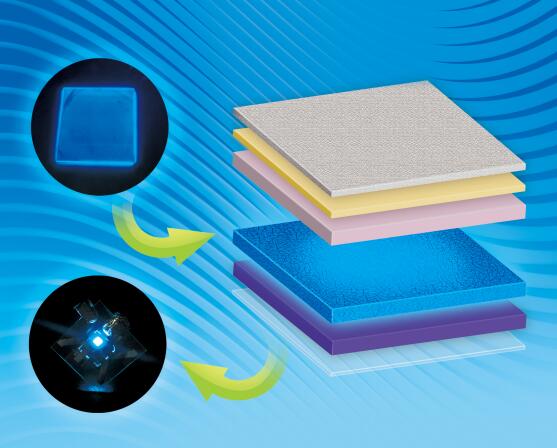SPECIAL TOPIC—Metamaterials
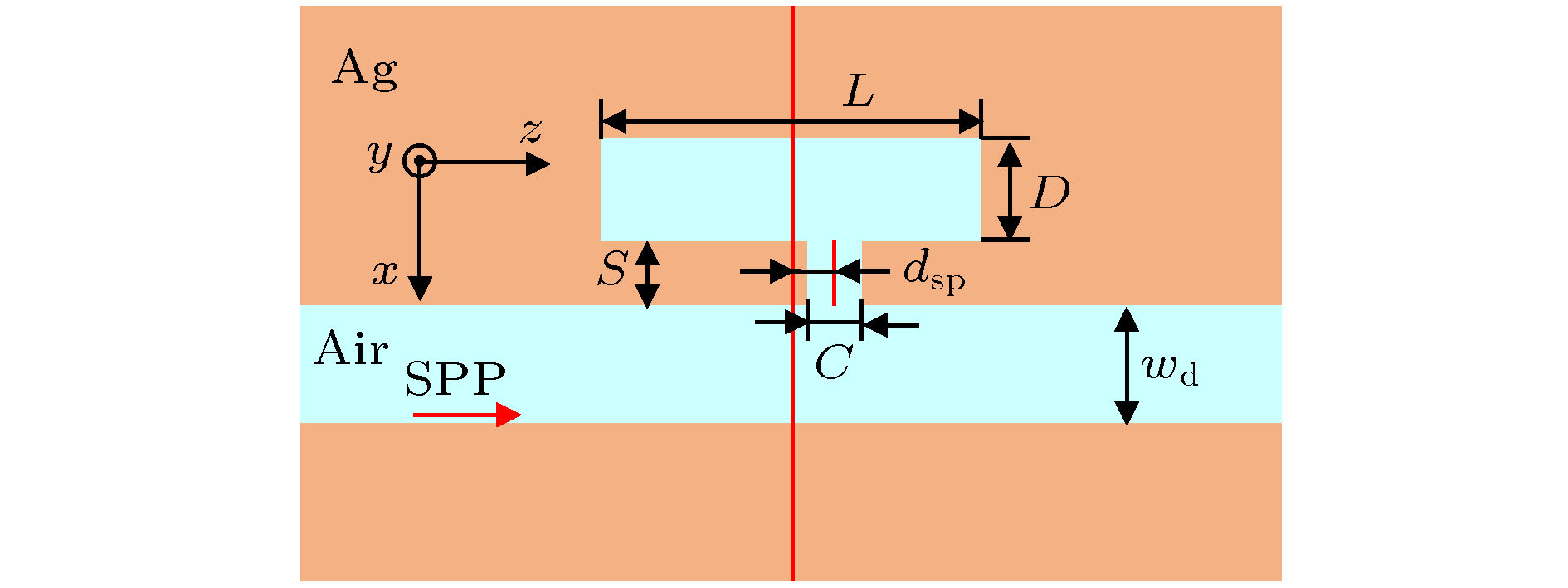
2020, 69 (13): 134205.
doi: 10.7498/aps.69.20200369
Abstract +
The coupled waveguide-microcavity structure has a wide range of applications in optical filters and optical modulators. The optical transmission properties of structure are mostly determined by the coupling strength of the modes. In the conventional waveguide-microcavity structure, the mode coupling is finished by the form of evanescent field, which is usually achieved by controlling the geometric spacing between waveguide and microcavity. Surface plasmon polaritons are the excitations of the electromagnetic waves coupled to collective oscillations of free electrons in metal. Since the electromagnetic waves are attenuated sharply in the metal, this requires precise control of the spacing between the waveguide and the metal microcavity, and poses a great challenge for controlling the coupling of modes in the metal waveguide-cavity structure. In this paper, we proposed a scheme of using a metal-dielectric-metal waveguide side coupling metal microcavities to overcome this limit. Based on the resonant characteristics of the Fabry–Pérot mode in the metal microcavity, a slit is introduced to connect the waveguide and microcavities. By adjusting the width and the offset location of slits, the leakage rate and coupling strength of the mode in metal microcavity can be controlled. The finite difference frequency domain (FDFD) method was used to numerically simulate the electromagnetic properties of structure. First, we have studied the transmission behaviors of surface plasmon polaritons in the system consisted by metal waveguide and single microcavity. As other microcavity is introduced to the structure and connected the original microcavity by slit, the electromagnetically induced transparency phenomena based on surface plasmon polaritons are demonstrated in the coupled metal waveguide and double microcavities structure. As the width of slit connected the microcavity is increased, the transmission peak of structure and the full width at half maximum of the transparency window also increase accordingly. The change of the geometric parameters of slit will modulate the resonance characteristics of structure, and the corresponding physical mechanism is explained by the temporal coupled mode theory. In our works, the metal waveguide and microcavities are coupled by the energy leakage of microcavities assisted by slits, which breaks the limit of separation distance between metal waveguide and microcavity, and contributes to the manufacture of devices. The results of the paper will have applications in designing the compact photonic devices based on surface plasmon polaritons.
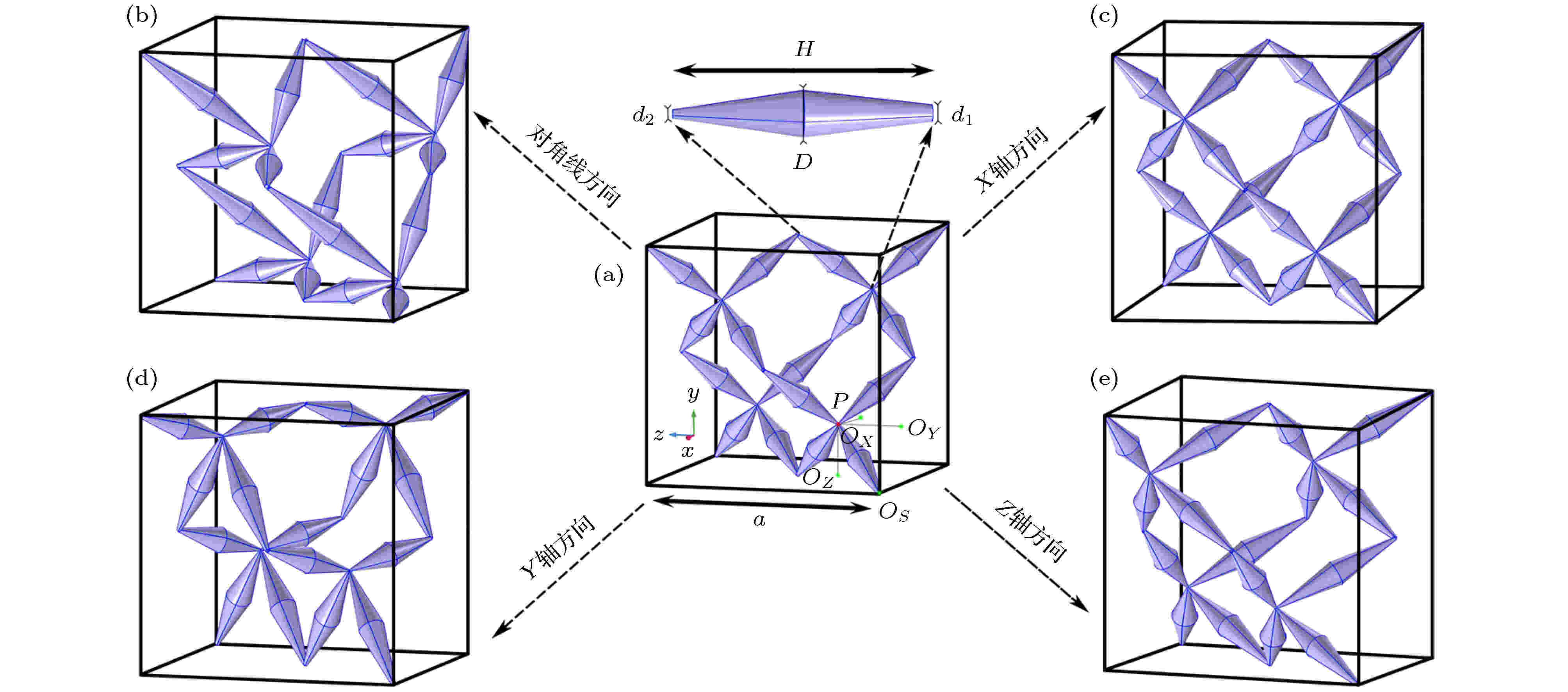
2020, 69 (13): 134302.
doi: 10.7498/aps.69.20200364
Abstract +
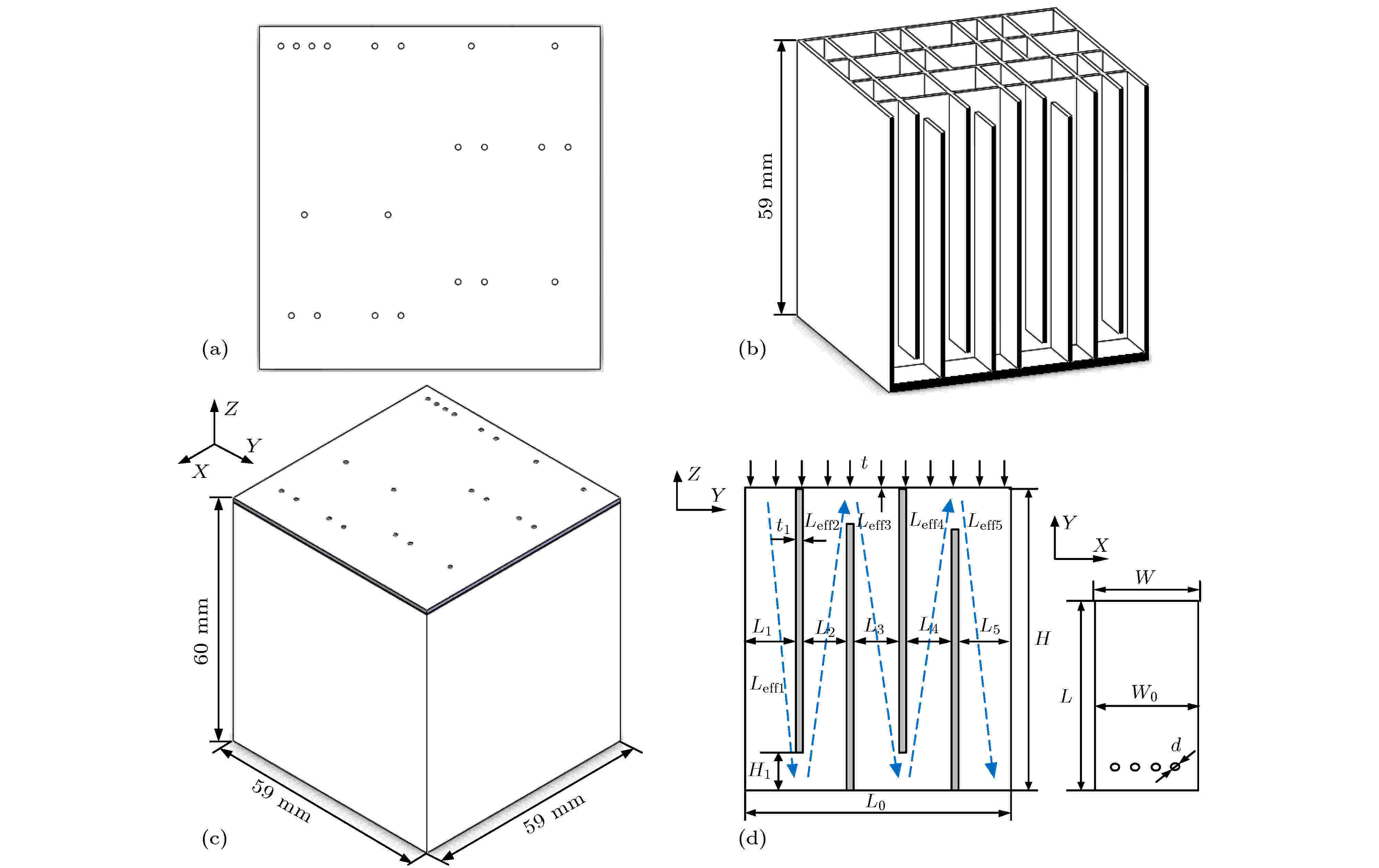
2020, 69 (13): 134303.
doi: 10.7498/aps.69.20200368
Abstract +
In this paper, we propose a hybrid subwavelength broadband sound absorber based on micro perforated plate and multiple coiled channels. And the mechanism of low frequency broadband sound absorption of the hybrid sound absorber is analyzed in detail. Based on this, the theoretical analysis model and the finite element numerical analysis model are established, and the mutual verification of theoretical and numerical solutions is completed. The structure can theoretically achieve the low-frequency and high-efficiency sound absorption with an average absorption coefficient of 0.8 in a frequency band of 200–500 Hz when the overall thickness of the sound absorbing structure is 60 mm. At the same time when the overall thickness is 90 mm, quasi-perfect sound absorption with peaks up to 0.95 in a frequency range of 180–350 Hz is realized theoretically. The composite sound absorption structure has a certain application prospect in engineering low frequency noise in future.
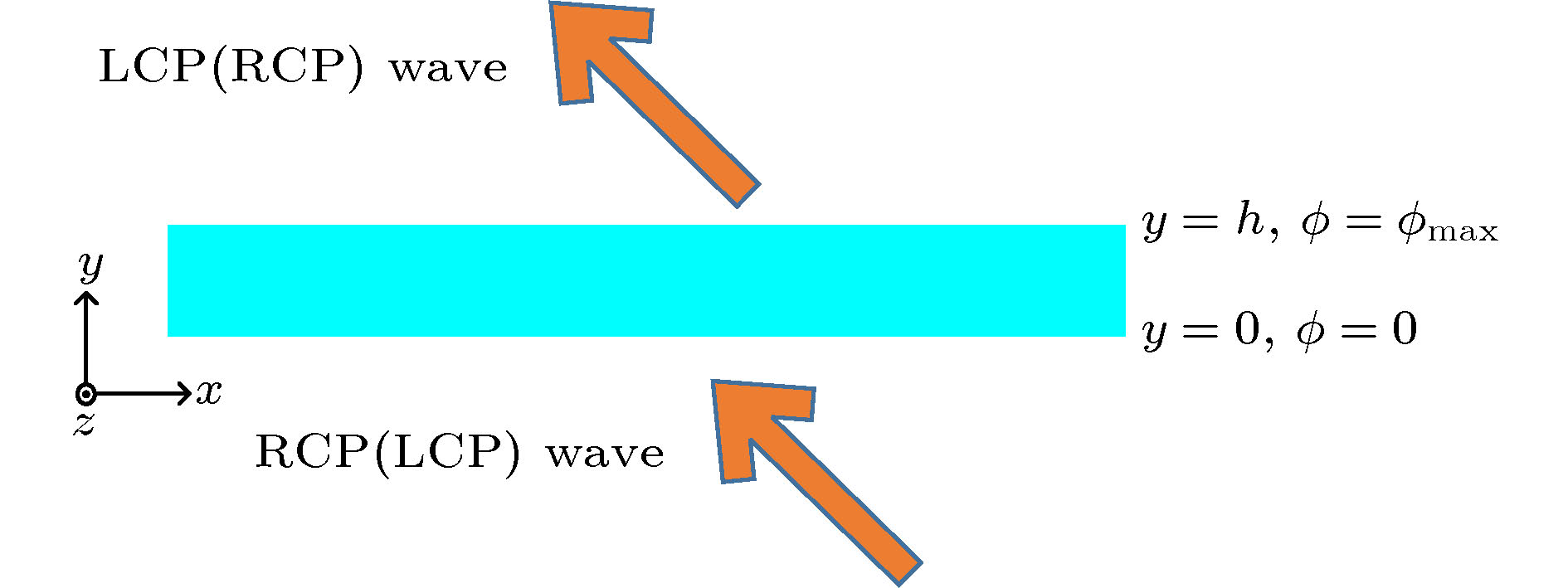
2020, 69 (13): 135201.
doi: 10.7498/aps.69.20200365
Abstract +
The Field transformation (FT) is a novel theory for controlling the polarization and impedance of electromagnetic waves, which is independent on the angle of incidence. Thus, the FT method is superior for wide-angle devices design. In this paper, we propose a wide-angle method for generating vortex beam based on the FT theory. According to this method, an artificial media for vortex beam generation is designed and simulated, which demonstrates the proposed method. The designed artificial media is a multi-layered structure, which can generate vortex beam of order 2 with an incident angle stability up to 60°.
REVIEW
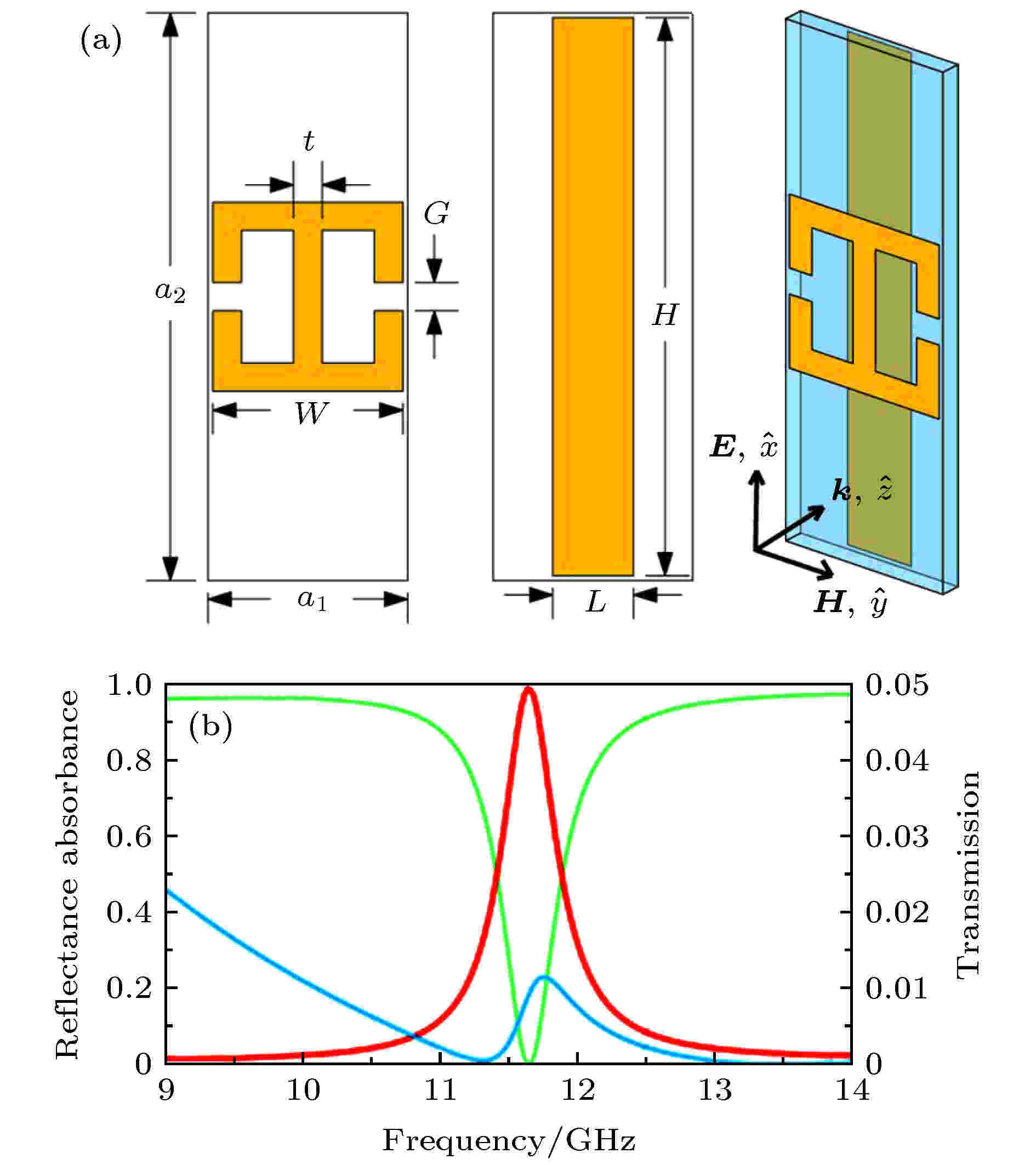
2020, 69 (13): 134101.
doi: 10.7498/aps.69.20200355
Abstract +
Electromagnetic absorbing technology can effectively suppress the radiation of electromagnetic waves, and has been widely used in military and civilian fields. However, traditional absorbing technology cannot meet the new requirements for modern absorbing materials. The advent of metamaterials provides a solution for this problem Metamaterial absorber has the advantages of simple structure, light weight, high absorption rate, and can realize the flexible control of electromagnetic waves, which has led the electromagnetic absorption research to rapidly develop. In this paper, the research and development of using metamaterials to absorb electromagnetic wave is reviewed. Firstly, the principle, implementation, and presently existing bottlenecks of electromagnetic wave absorption in using metamaterials are outlined. Secondly, recent progress of the aforementioned key issues in three aspects is introduced, including multi-band and broadband, polarization and angle independence, and dynamic tunability. Several typical methods of making metamaterial absorbers are illustrated here. Generally speaking, the prerequisite of broadband metamaterial absorbers is to provide multiple resonances that are close enough to each other. The structure with multiple rotationally symmetric geometry is helpful in achieving polarization- and angle-insensitive properties. The flexible control of absorption performance can be realized by introducing lumped elements such as resistances, capacitances, and diodes. In addition, by means of composite traditional materials or new materials and other methods the dynamic adjustment of the absorption performance can be achieved. Although researchers have done a lot of work on the metamaterial absorbers, there remain many problems and challenges. For the future design, several promising directions are suggested from three perspectives: high performance, multifunctionality, and new structures. In terms of high performance, it is still a challenge to achieve ultra-thin broadband metamaterial absorber for low-frequency which can break through the limitation of wavelength. Integrated multifunctional metamaterials can adapt to the increasingly complex application scenarios and should gradually become the focus of attention. Since three-dimensional (3D) printing technology has proved to be applicable to the preparation of complex metamaterial structures, the new 3D metamerial absorbers will bring more vitality to the development of metamaterials. Finally, as regards the application of metamaterials in stealth, the future development of metamaterial absorbers is further summarized.
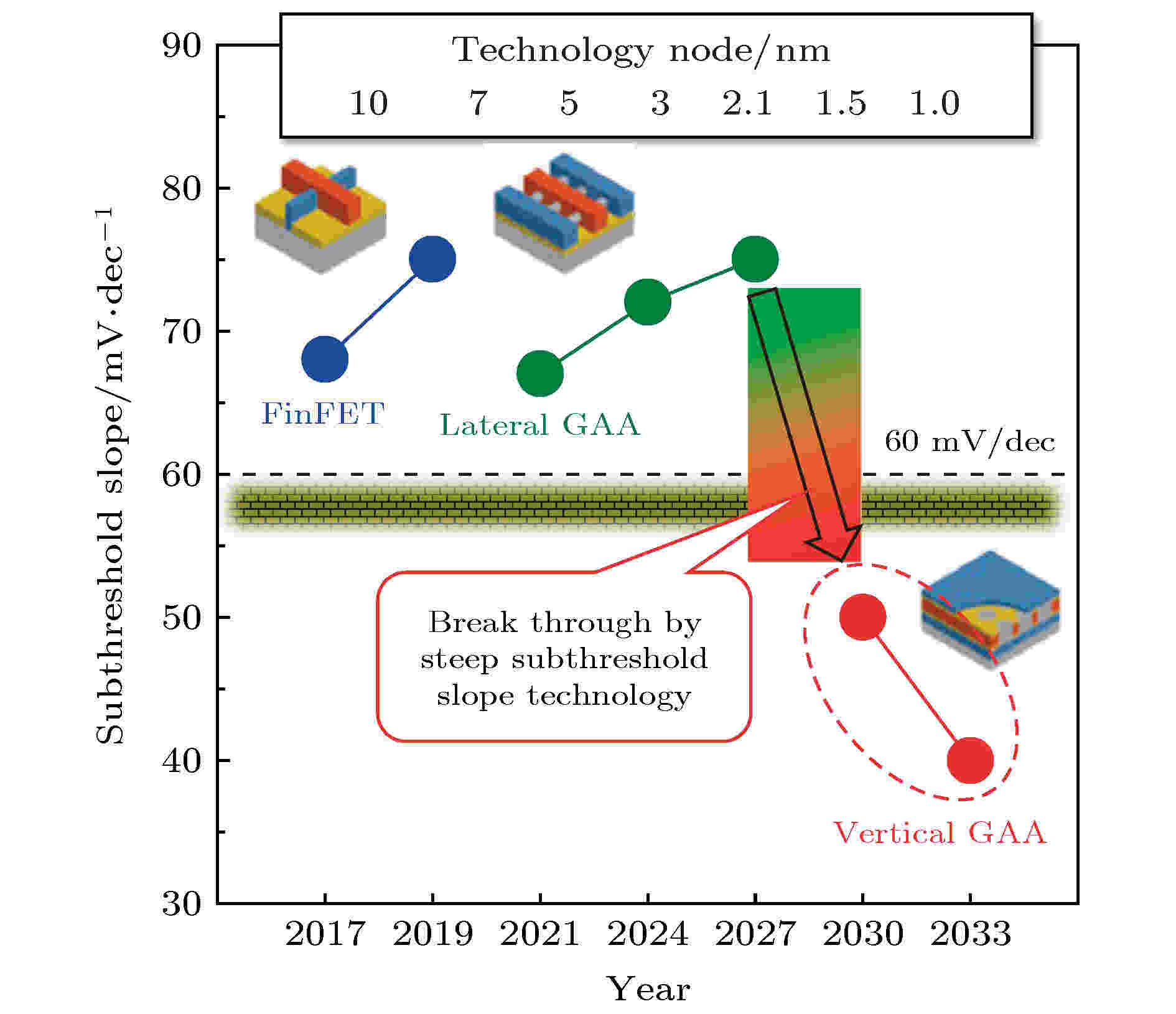
2020, 69 (13): 137701.
doi: 10.7498/aps.69.20200354
Abstract +
Ferroelectric negative capacitance field effect transistors(Fe-NCFETs) can break through the so-called “Boltzmann Tyranny” of traditional metal oxide semiconductor field effect transistors and reduce the subthreshold swing below 60 mV/dec, which could greatly improve the on/off current ratio and short-channel effect. Consequently, the power dissipation of the device is effectively lowered. The Fe-NCFET provides a choice for the downscaling of the transistor and the continuation of Moore’s Law. In this review, the representative research progress of Fe-NCFETs in recent years is comprehensively reviewed to conduce to further study. In the first chapter, the background and significance of Fe-NCFETs are introduced. In the second chapter, the basic properties of ferroelectric materials are introduced, and then the types of ferroelectric materials are summarized. Among them, the invention of hafnium oxide-based ferroelectric materials solves the problem of compatibility between traditional ferroelectric materials and CMOS processes, making the performance of NCFETs further improved. In the third chapter, the advantages and disadvantages of Fe-NCFETs with MFS, MFIS and MFMIS structures are first summarized, then from the perspective of atomic microscopic forces the “S” relationship curve of ferroelectric materials is derived and combined with Gibbs free energy formula and L-K equation, and the intrinsic negative capacitance region in the free energy curve of the ferroelectric material is obtained. Next, the steady-state negative capacitance and transient negative capacitance in the ferroelectric capacitor are discussed from the aspects of concept and circuit characteristics; after that the working area of negative capacitance Fe-NCFET is discussed. In the fourth chapter, the significant research results of Fe-NCFETs combined with hafnium-based ferroelectrics in recent years are summarized from the perspective of two-dimensional channel materials and three-dimensional channel materials respectively. Among them, the Fe-NCFETs based on three-dimensional channel materials such as silicon, germanium-based materials, III-V compounds, and carbon nanotubes are more compatible with traditional CMOS processes. The interface between the channel and the ferroelectric layer is better, and the electrical performance is more stable. However, thereremain some problems to be solved in three-dimensional channel materials such as the limited on-state current resulting from the low effective carrier mobility of the silicon, the small on/off current ratio due to the leakage caused by the small bandgap of the germanium-based material, the poor interfacial properties between the III-V compound materials and the dielectric layer, and the ambiguous working mechanism of Fe-NCFETs based on carbon nanotube. Compared with Fe-NCFETs based on three-dimensional channel materials, the Fe-NCFETs based on two-dimensional channel materials such as transition metal chalcogenide, graphene, and black phosphorus provide the possibility for the characteristic size of the transistor to be reduced to 3 nm. However, the interface performance between the two-dimensional channel material and the gate dielectric layer is poor, since there are numerous defect states at the interface. Furthermore, the two-dimensional channel materials have poor compatibility with traditional CMOS process. Hence, it is imperative to search for new approaches to finding a balance between device characteristics. Finally, the presently existing problems and future development directions of Fe-NCFETs are summarized and prospected.
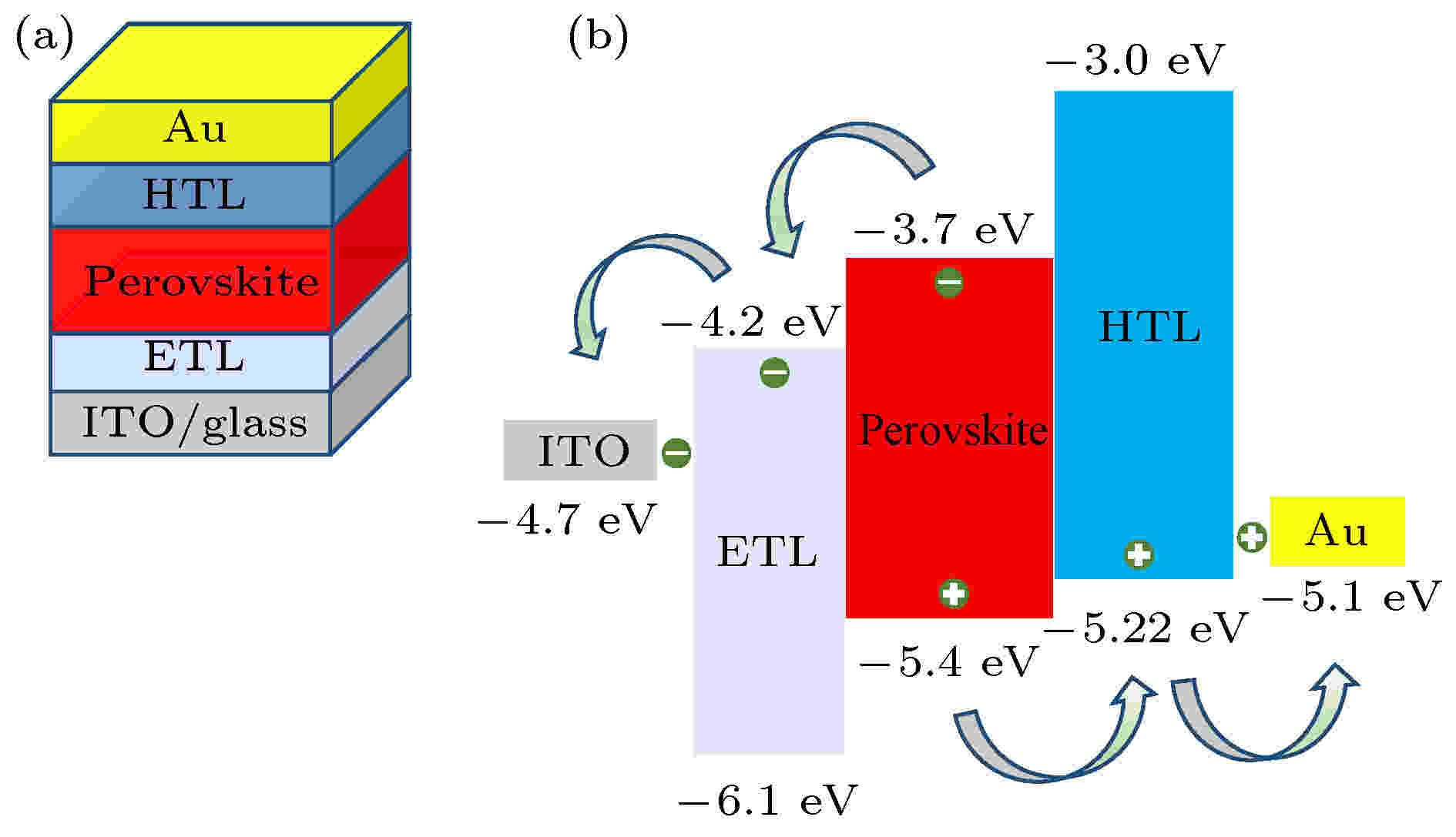
EDITOR'S SUGGESTION
2020, 69 (13): 138401.
doi: 10.7498/aps.69.20200543
Abstract +
Based on the excellent optoelectronic properties of organic-inorganic hybrids perovskite materials, the power conversion efficiency of perovskite solar cells (PSCs) is rapidly increasing. However, factors that restrict the performance of PSCs still exist, such as interface and stability problems. Problems, such as band mismatching, carrier recombination and chemical reaction between interfaces, could be alleviated by introducing a buffer layer (BL) with a proper band structure between different layers. Moreover, stability as well as charge separation and collection could also be efficiently improved in PSCs. In this paper, an overview of the most contemporary strategies of BLs was provided. The passivation mechanism of BLs at different interfaces are highlighted and discussed in detail. Furthermore, the performances of recently developed BLs in PSCs are compared. Finally, we elaborate on the remaining challenges and future directions for the development of BLs to achieve high-efficiency and high-stability PSCs.
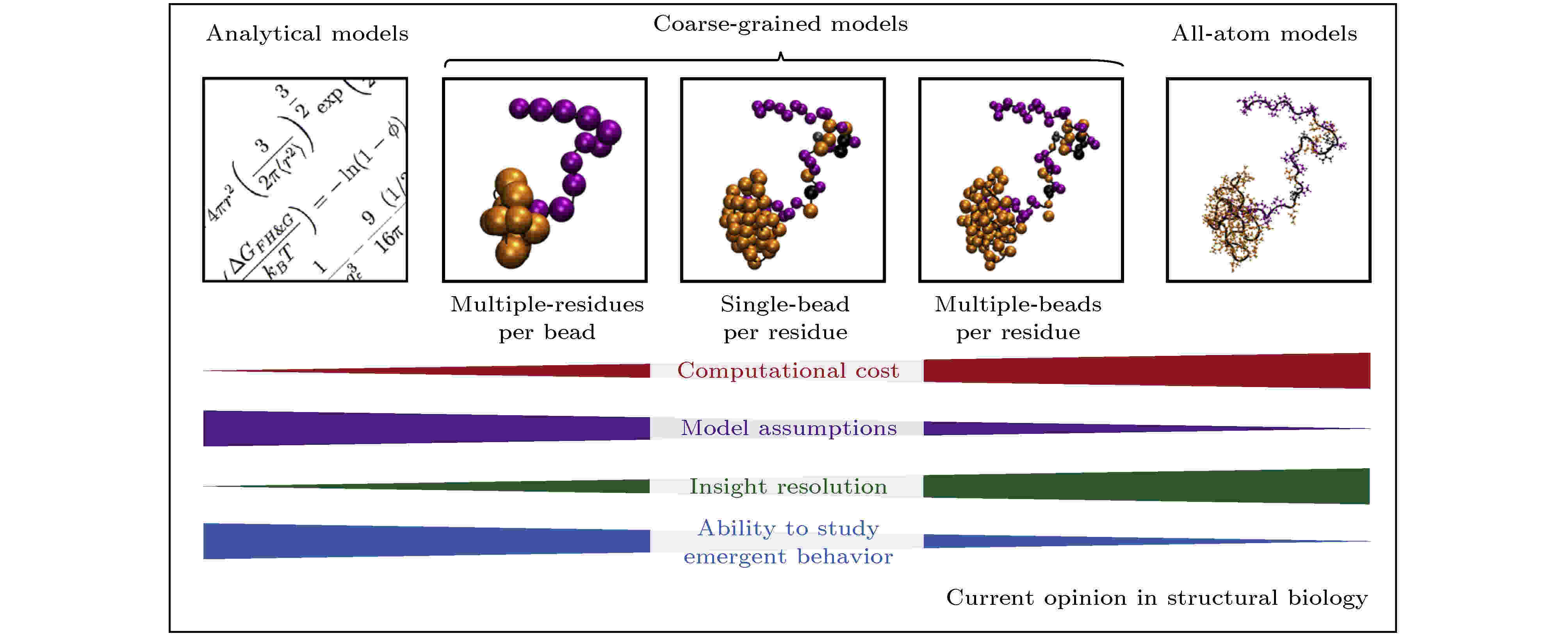
2020, 69 (13): 138701.
doi: 10.7498/aps.69.20200438
Abstract +
Liquid-liquid phase separation (LLPS) of proteins is an emerging field in the research of biophysics. Many intrinsically disordered proteins (IDPs) are known to have the ability to assemble via LLPS and to organize into protein-rich and dilute phases both in vivo and in vitro. Such a kind of phase separation of proteins plays an important role in a wide range of cellular processes, such as the formation of membraneless organelles (MLOs), signaling transduction, intracellular organization, chromatin organization, etc. In recent years, there appeared a great number of theoretical analysis, computational simulation and experimental research focusing on the physical principles of LLPS. In this article, the theoretical and computational simulation methods for the LLPS are briefly reviewed. To elucidate the physical principle of LLPS and to understand the phase behaviors of the proteins, biophysicists have introduced the concepts and theories from statistical mechanics and polymer sciences. Flory-Huggins theory and its extensions, such as mean-field model, random phase approximation (RPA) and field theory simulations, can conduce to understanding the phase diagram of the LLPS. To reveal the hidden principles in the sequence-dependent phase behaviors of different biomolecular condensates, different simulation methods including lattice models, off-lattice coarse-grained models, and all-atom simulations are introduced to perform computer simulations. By reducing the conformational space of the proteins, lattice models can capture the key points in LLPS and simplify the computations. In the off-lattice models, a polypeptide can be coarse-grained as connected particles representing repeated short peptide fragments. All-atom simulations can describe the structure of proteins at a higher resolution but consume higher computation-power. Multi-scale simulation may provide the key to understanding LLPS at both high computational efficiency and high accuracy. With these methods, we can elucidate the sequence-dependent phase behaviors of proteins at different resolutions. To sum up, it is necessary to choose the appropriate method to model LLPS processes according to the interactions within the molecules and the specific phase behaviors of the system. The simulations of LLPS can facilitate the comprehensive understanding of the key features which regulate the membraneless compartmentalization in cell biology and shed light on the design of artificial cells and the control of neurodegeneration.
GENERAL

2020, 69 (13): 130201.
doi: 10.7498/aps.69.20191431
Abstract +
The tropopause, as a transition layer between the troposphere and the stratosphere, has a significant influence on the inversion of trace gas concentration. Theoretical analysis of the influence of tropopause on the vertical distribution of atmospheric molecular content, combined with Lhasa observation data, is presented, and the quantitative analysis of the influence of tropopause on the inversion of column-averaged dry air mole fractions (DMFs) is given as well. The comparison results show that the tropopause height has a great influence on the inversion results. First, its height variation has a little effect on XH2O, but it has a great influence on XCO2, XCH4 and XCO. The XCO2 and XCH4 have positive correlation with tropopause height variation, but for XCO, negative correlation with the tropopause height variation is observed. The correlation coefficient of XCO2, XCH4 and XCO are 0.998, 0.78 and 0.994, respectively. When the tropopause height is varied by 3 km, XCO2, XCH4 and XCO are varied by 8.64%、0.0354% and 0.0488%, respectively. The column-averaged dry air mole water vapor, carbon dioxide, carbon monoxide and methane in Lhasa are observed based on ground-based Fourier transform infrared spectrometer EM27/SUN. The time series of XH2O, XCO2, XCH4 and XCO in a period from August 6 to August 16, 2018 in Lhasa were obtained. The main achievements are as follows. In the observation period, the daily average value of XH2O, XCO2, XCH4 and XCO vary between 3432 and 4287 ppmv, 406.1 and 408.2 ppmv, 1.673 and 1.720 ppmv, and 0.082 and 0.095 ppmv, respectively. The average value of XH2O, XCO2, XCH4 and XCO are 3919.70, 406.887, 1.689, and 0.091 ppmv, res[ectively. Comparison between XCO2 and XCH4 time series shows that XCO2 and XCH4 time series have similar daily trends, the correlation coefficient between XCO2 and XCH4 time serires is higher than 0.5. In particular, the correlation coefficient reached about 0.86 on August 7, 8, 13, 2018. High correlation coefficient indicates that CO2 and CH4 molecules come from the same source. Compared with the WACCM simulation values, the XCO2 and XCH4 of the ground-based observations are small. The observation results can provide reference and first-hand direct observation data for the study of the temporal and spatial distribution of greenhouse gases in the temperate zone of the plateau in China.

2020, 69 (13): 130202.
doi: 10.7498/aps.69.20191877
Abstract +
The impact phase transformation of body-centered-cubic iron is one of the hotspots in current research. Many studies demonstrated that when iron is impacted along the [100] direction, body-centered-cubic phase will transform into hexagonal close-packed phase; while when it is impacted along the [101] direction, a certain amount of face-centered-cubic phase will also appear besides hexagonal close-packed phase. The transformation from body-centered-cubic to hexagonal close-packed phase has been clarified, however, the transformation from body-centered-cubic to face-centered-cubic phase still needs further exploring. In the present work, molecular dynamics simulation is used to study the phase transformation of body-centered-cubic iron impacted along the [101] direction. The results show that the body-centered-cubic phase will transform into a close-packed structure including hexagonal close-packed phase and face-centered-cubic phase). The formation mechanism of face-centered-cubic phase is as follow. In the loading process, single crystal iron suddenly contracts along the [101] and $ [\bar101] $ directions, and expands along the [010] direction, leading to the transformation from body-centered-cubic phase to face-centered-cubic phase. The formation mechanism of hexagonal close-packed phase can be divided into two stages: first, (101) plane is compressed into close-packed plane, then hexagonal close-packed phase is obtained by the relative sliding of adjacent close-packed planes. To further investigate the formation mechanism of the close packed structure, the effect of stress state on the phase transformation of body-centered-cubic iron is further studied. Under one-dimensional (along the [101] direction) or two-dimensional loading (along [101] and $ [\bar101] $ directions), the body-centered-cubic iron transforms into face-centered-cubic iron. In the loading process the lattice constants along the three dimensions are monitored. When the transformation from body-centered-cubic phase to face-centered-cubic phase finishes, the ratio of lattice constants along three directions is 1∶1∶1.31 under one-dimensional loading; while the ratio of lattice constants is 1∶1∶1 under two-dimensional loading. Obviously, the body-centered-cubic phase transforms into distorted face-centered-cubic phase under one-dimensional loading. Under two-dimensional (along the [101] and [010] direction) and three-dimensional loading (along the [101], [010] and $ [\bar101] $ direction), the body-centered-cubic phase transforms into hexagonal close-packed phase. Gibbs free energy value for each of BCC, HCP and FCC phase is calculated. The calculation results show that the BCC phase is stable under low pressure, while the HCP and FCC phase are stable under high pressure. Finally, based on Gibbs free energy and the effect of stress state on the phase transformation, the phase transformation mechanism of body-centered-cubic iron under [101] impaction is investigated, and a reasonable explanation for the phase transformation is obtained.

EDITOR'S SUGGESTION
2020, 69 (13): 130301.
doi: 10.7498/aps.69.20200042
Abstract +
Based on the cascaded four wave mixing processes, a coherent-feedback control system is constructed by utilizing a linear beam splitter as the feedback controller. Considering the loss of optical propagation in the coherent feedback loop and the absorption effect of Rb vapor cells to beams, we theoretically investigate the entanglement properties of this system under different feedback ratio, gain and phase by calculating the covariance matrix of system and applying the positivity under partial transpose (PPT) criterion to all possible bipartitions. The result shows that the genuine tripartite entanglement exists in the coherent feedback control system, but the entanglement structure of system will be destroyed by the excessive feedback. In addition, when the phase is π, we find that the tripartite entanglement can be enhanced by changing the gains and the reflectivity of the beam splitter in the range of 0.1 to 0.4. The results pave the way for manipulating multipartite entanglement by coherent feedback control and have potential application in quantum communication.
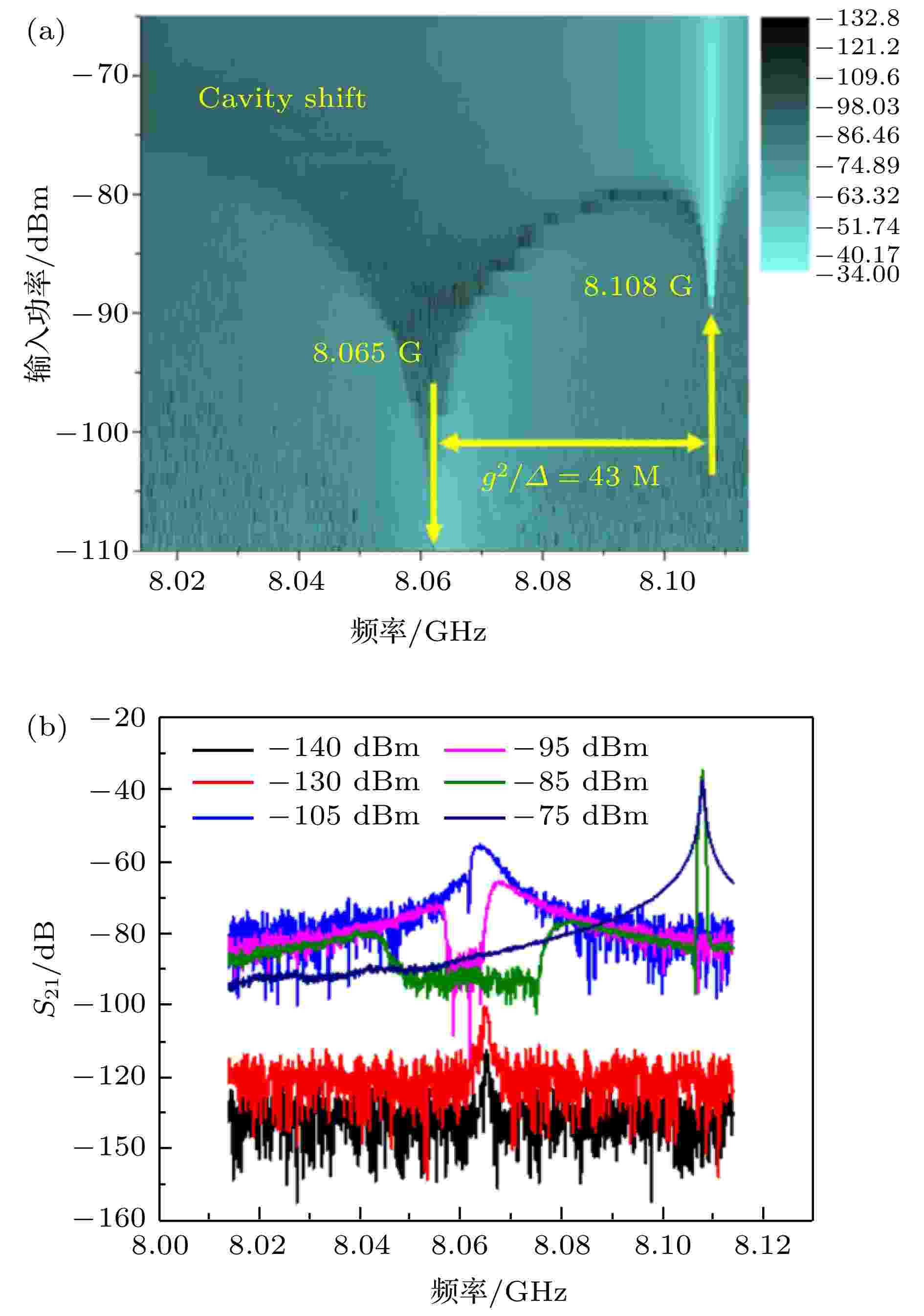
2020, 69 (13): 130302.
doi: 10.7498/aps.69.20200252
Abstract +
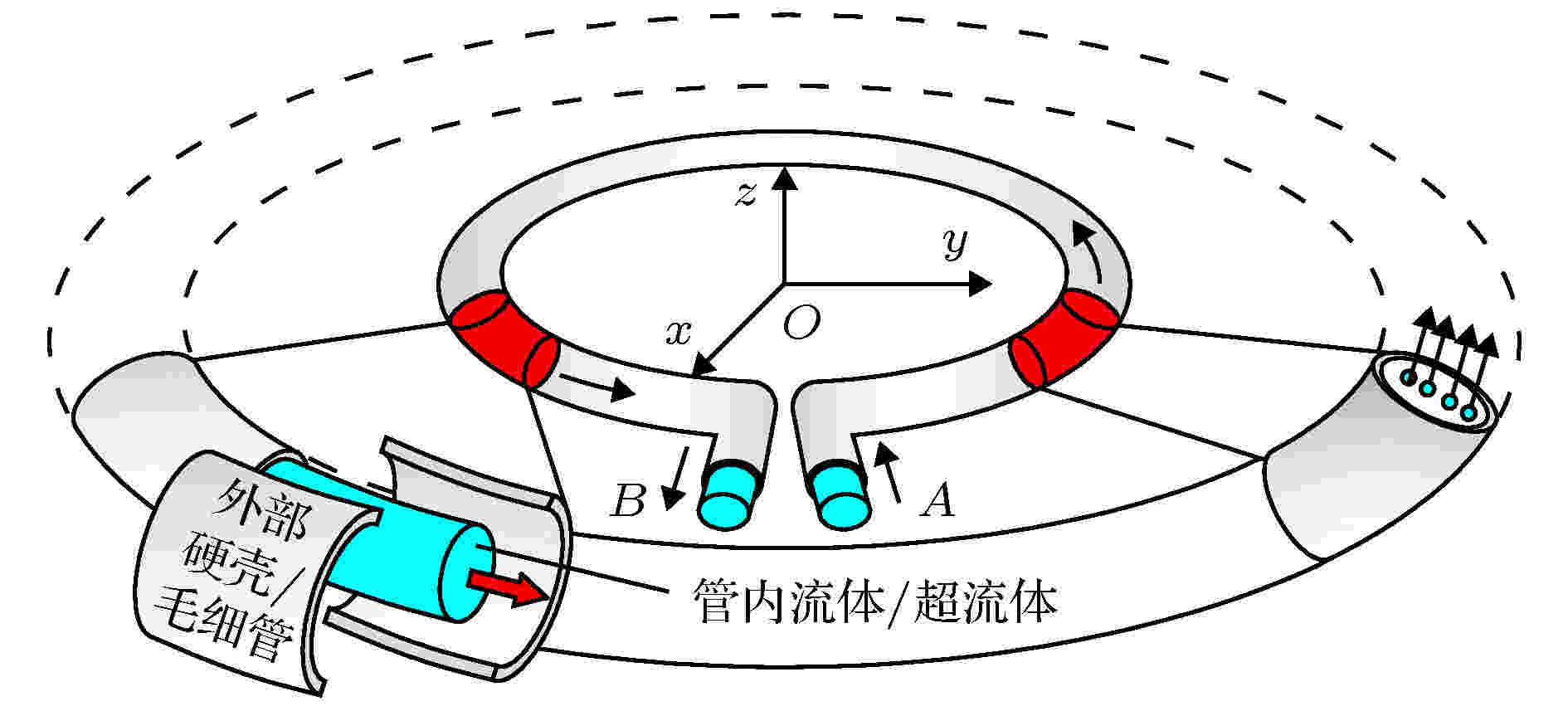
2020, 69 (13): 130401.
doi: 10.7498/aps.69.20191673
Abstract +
According to the General Relativity (GR), under the approximation of the weak field, the weak gravitational field not only contains the classical Newtonian gravitational field, but also contains a gravitomagnetic (GM) field analogous to the concept of magnetic field, and the name of GM field borrows the basic idea of the magnetic field in electrodynamics. In order to study the physical properties of GM field and its associated effects, firstly, we use a similarity transformation method to decompose the gravitomagnetic component from the second-order tensor field in linearized Einstein field equation and define the concept of the GM field. Then, on this basis, we consider a circular microtube model with uniform velocity fluids (or superfluids), and study the distribution characteristics of the far GM field by this special model. We use a simpler approximation approach to improve the previous calculation method of the GM field in these kind of rings model, the result shows that the distribution characteristic of the far GM field in this model is analogous to the magnetic field produced by a dipole, it is a good correspondence between this microtube model and the dipole model. After that, we have studied the dynamic characteristics of GM field by analogizing the properties of magnetic field, and studied the test particles’ tracks in the linear time-varying GM field and the cosine time-varying GM field in the first time. In addition, in order to improve the previous research methods of ‘gravitational induction’ and ‘frame dragging’ in the GR, we have designed a circular microtube model which has a double-layer structure and with the accelerating flow fluid (or superfluids), we use simpler mathematics than before to explain these two effects by this special model. In conclusion, this work provides some new methods for the study of GM field and its associated effects.

2020, 69 (13): 130501.
doi: 10.7498/aps.69.20191879
Abstract +
In thermodynamics of irreversible processes, the entropy production rate (EPR) is usually generated by the rate of the entropy change of the system due to its internal transitions and the entropy flows due to the interactions between the system and the environment. For the bipartite system, in addition to the factors mentioned above, the energy and information exchanges between the two subsystems will generate an additional entropy production in the EPR of a subsystem. To reveal the essence and role of the information flow, we build an open dissipative quantum system coupled to multiple electronic reservoirs with the same temperature and different chemical potentials. Based on the thermal and electron transport properties of a double quantum-dot system with Coulomb coupling, the EPR of each quantum dot and the information flow between subsystems are studied. Starting from the quantum master equation under the Born, Markov, and rotating-wave (or secular) approximations, we derive the EPRs of the total system and subsystems at the steady state. For purposes of relating the thermodynamic properties to the fundamental fluxes and affinities, a graph representation of the dynamics of the four-state model is introduced. Selecting a directed graph and a complete set of basic cycles by using Schnakenberg’s network theory, we show how the EPRs of the total system and the subsystems relate to global and local cycle fluxes. It is found that the energy and information exchanges between the quantum dots depend on the global cycle flux. The EPRs induced by the electron flows due to the chemical potential difference as well as the energy and information exchanges between the subsystems are the key elements of thermodynamic irreversibilities. The EPRs caused by the information exchange guarantee the continuous electron transports. The EPRs and the coarse-grained EPRs of the subsystems varying with the Coulomb coupling strength are obtained numerically. The results demonstrate that the information flows in the process of internal exchange become important to fully understand the operation mechanism of the bipartite system. Without violating the second law of thermodynamics, the information can be regarded as a driving force to move electrons from low to high chemical potential.
ATOMIC AND MOLECULAR PHYSICS

2020, 69 (13): 133401.
doi: 10.7498/aps.69.20200264
Abstract +
In this paper, pure thick Al (Z = 13), Ti (Z = 22), Zr (Z = 40), W (Z = 74) and Au (Z = 79) targets are bombarded by electrons in an energy range of 5–27 keV, and the experimental thick-target characteristic X-ray yields of K-shell and L-shell, the X-ray production cross sections and the ionization cross sections of inner shells are presented. The present experimental setup and data processing are improved, specifically, a deflection magnet is installed in front of the X-ray detector to prevent the backscattered electron from entering into the X-ray detector, and the bremsstrahlung background spectra calculated from PENELOPE Monte Carlo simulations are used to deduce the net peak areas. The X-ray detector used in this experiment is the XR-100SDD manufactured by Amptek Inc. with a 25 mm2 C2 ultra-thin window which can detect the low-energy x-rays down to boron Kα line (0.183 keV). Standard sources (55Fe, 57Co, 137Cs and 241Am) with an activity accuracy range of 1%–3% (k = 2), supplied by the Physikalisch-Technische Bundesanstalt, Germany (PTB), are used to perform the detector’s efficiency calibration, and in a low-energy range (< 3.3 keV) the efficiency calibration is accomplished by measuring characteristic X-ray spectra produced by 20 keV electron impacting various thickness solid targets (i.e. by the characteristic peak method). The uncertainty of the detector’s efficiency calibration obtained in this paper is ~1.6%. The experimental thick-target characteristic X-ray yield data with an uncertainty of 1.7%–6.2% are compared with the PENELOPE Monte Carlo simulations, in which the inner-shell ionization cross sections are based on the distorted-wave Born approximation (DWBA) calculations, and they are in good agreement with a difference of less than or ~10%. According to the measured thick-target characteristic x-ray yields, the K-shell ionization cross sections for Al, Ti and Zr and the L-shell X-ray production cross sections for Zr, W and Au are also obtained with an uncertainty of 5%–8% (except for Al due to large K-shell fluorescence yield uncertainty), the difference between the experimental and theoretical data is also less than or ~10%. Moreover, by comparing the thick-target characteristic X-ray yields obtained from the analytical model and the PENELOPE Monte Carlo simulations at the electrons’ incident angles of 45° and 90°, it is found that the degree of agreement between the results from the analytical model and the Monte Carlo simulations at the incident angle of 90° is better than at the incident angle of 45°. Moreover, the contributions of the secondary electrons and bremsstrahlung photons to the characteristic X-ray yield are also given based on the PENELOPE Monte Carlo simulations. As for the elements studied in this paper, for the low ionization threshold energy, the contribution of the secondary electrons is ~2%, and however, for the high ionization threshold energy, the contribution is ~10%–20%. These contributions depend weakly on the energy of the incident electrons and show that these contributions are closely correlated with atomic number.
ELECTROMAGNETISM, OPTICS, ACOUSTICS, HEAT TRANSFER, CLASSICAL MECHANICS, AND FLUID DYNAMICS
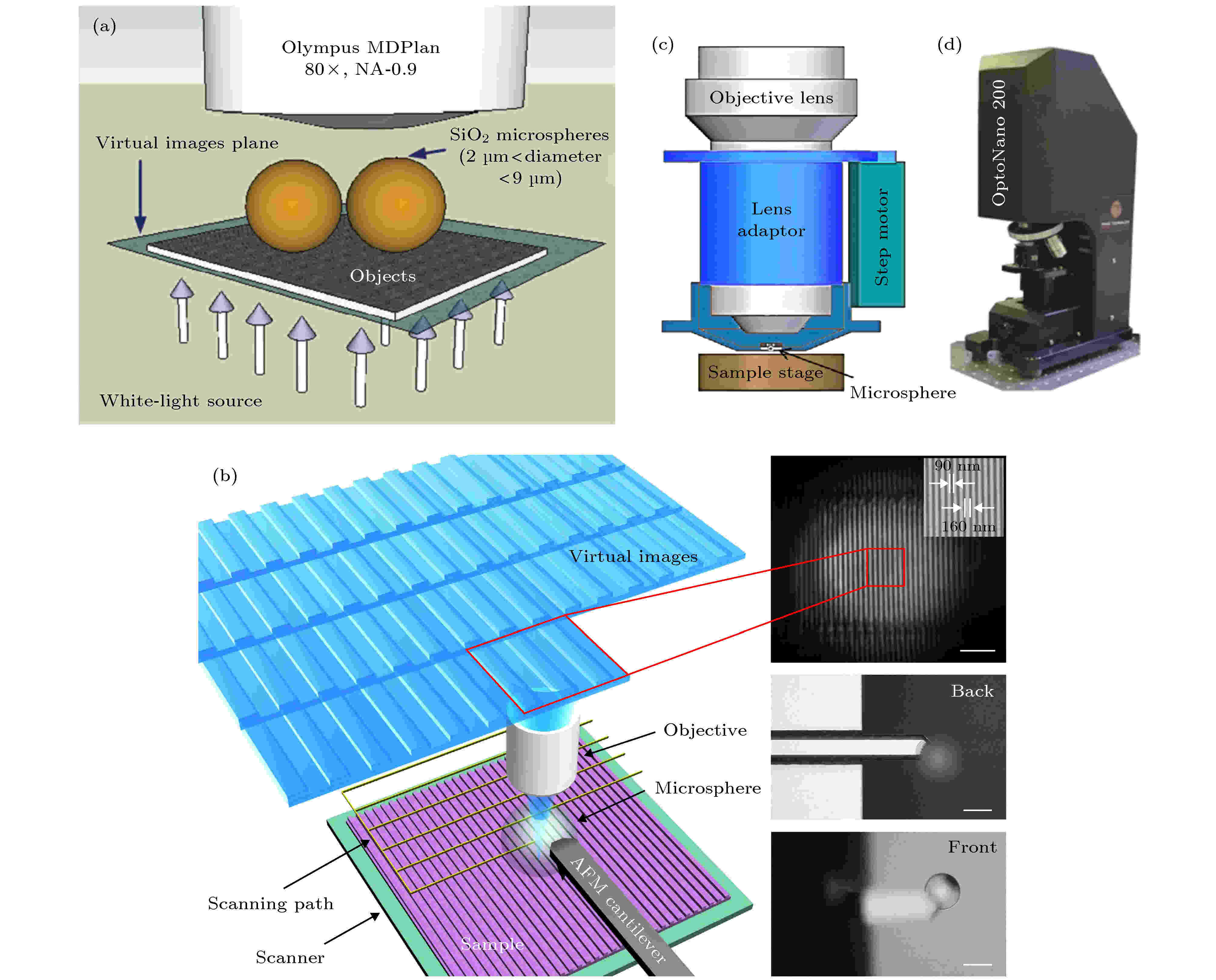
2020, 69 (13): 134201.
doi: 10.7498/aps.69.20191994
Abstract +
White-light super-resolution imaging, proposed in 2011, has been achieved by combining the transparent microspheres of the micron scale with an ordinary optical microscope. At present, in most of the researches employed is the way of spreading microspheres directly onto the surface of sample, which causes the randomness and discontinuity of microspheres. It is impossible to achieve the complete imaging of specific regions, which greatly limits the application scope of this technology. Such an issue can be solved by using microprobes or micro-cantilevers to precisely transfer the location of microsphere, but for doing so, a sophisticated controlling system is required, which is costly and not user-friendly. In this paper, a robust, controllable, easy-to-use integrated design which can efficiently consolidate microsphere and objective together is demonstrated for super-resolution imaging. The PDMS and customized metal sleeve are used to encapsulate the microsphere semi-submerged on the ordinary objective lens to achieve an integrated design. In this system, the distances among the microsphere, objective lens and the sample are controlled accurately by building a side-view imaging and position feedback system. With the help of a universal microscopic imaging system, the super-resolution imaging of specific controlled areas is realized. Based on theoretical analysis, the semi-submerged structure of the 100-μm-diameter BaTiO3 microsphere has a strong focusing effect, which can form the so-called ‘photonic nanojet’ on a micro-scale in length and on a sub-diffraction scale in waist to possess the ability to break through the diffraction limit within the range of focal length. At the same time, experiments are carried out for investigating imaging performances at various working distances in the air. According to the experimental results, the system can clearly distinguish between the CPU lattice features of 200 nm and the Blu-ray disc fringe of 100 nm, which means that the resolution of the ordinary microscopic objective lens (40×, NA 0.6) is significantly enhanced by 4.78×. In addition, with the increase of working distance, the magnification factor increases gradually, but the image contrast becomes worse, and the super-resolution effect fades. The integrated design which can match with ordinary optical microscope to achieve super resolution imaging has universality of installation and operation, and greatly conduces to super-resolution imaging of sub-diffraction limit samples.
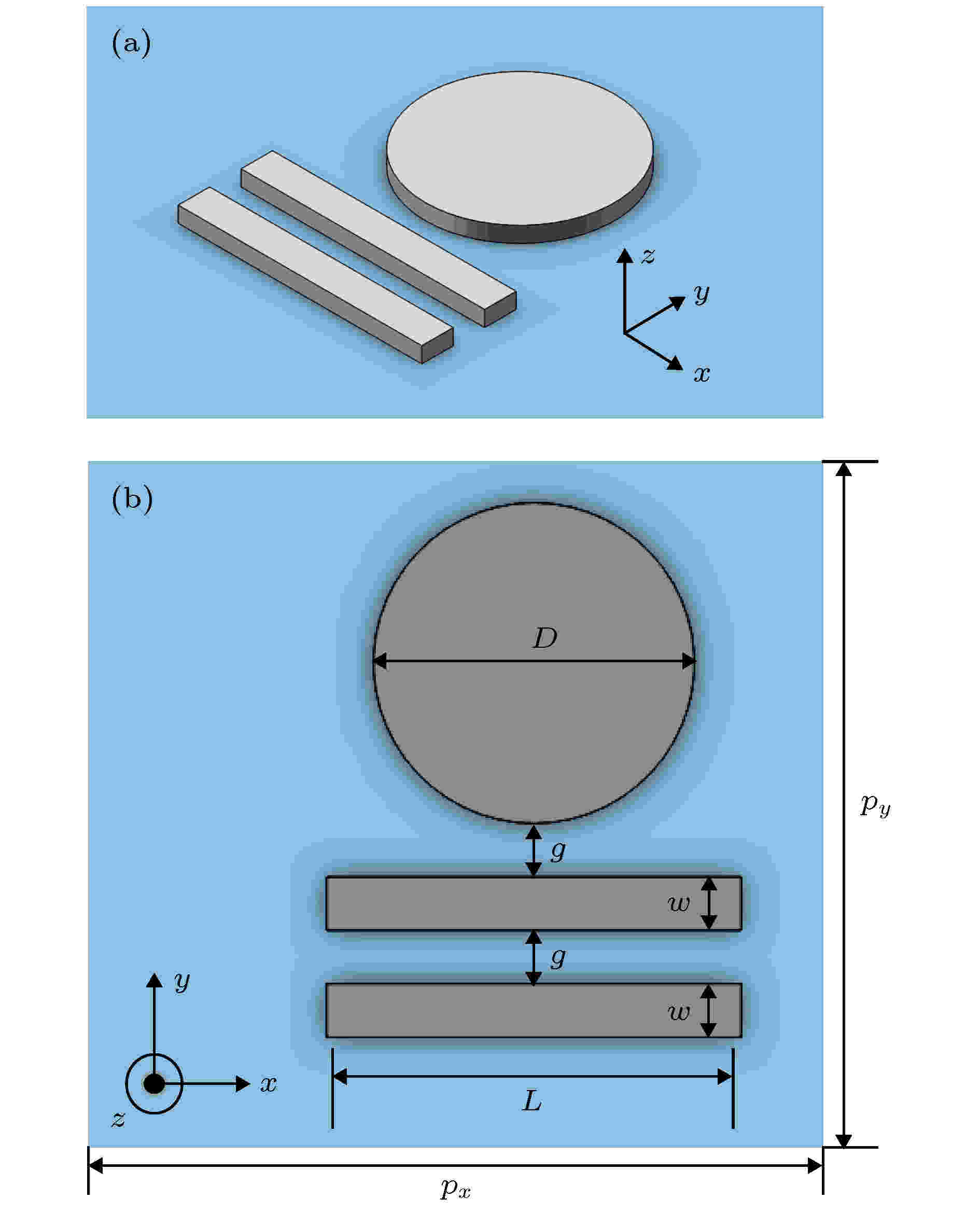
2020, 69 (13): 134202.
doi: 10.7498/aps.69.20200093
Abstract +
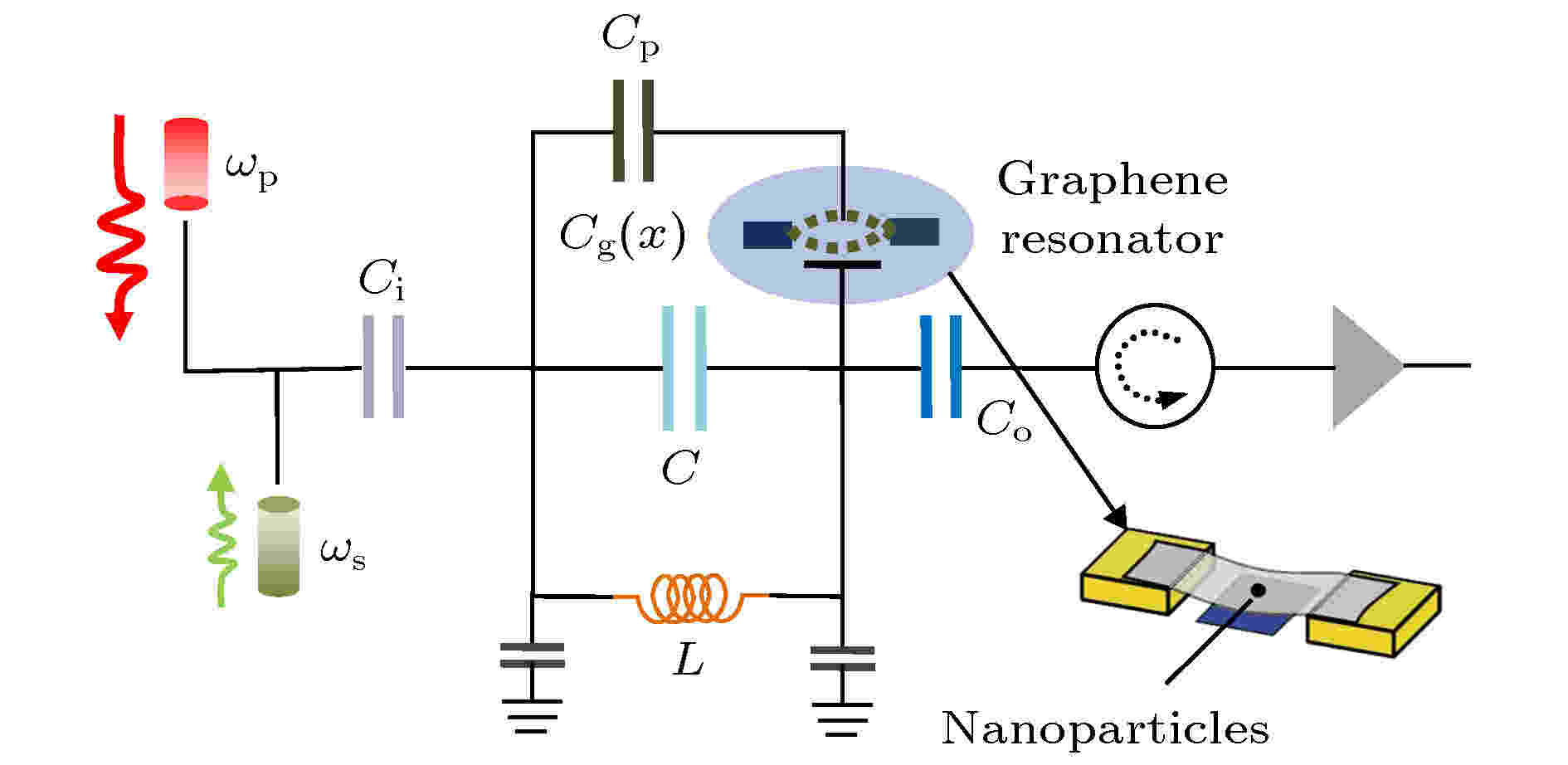
2020, 69 (13): 134203.
doi: 10.7498/aps.69.20191745
Abstract +
Graphene, atomically thin two-dimensional (2D) nanomaterial consisting of a single layer of carbon atoms, has received tremendous attention in the past few decades. Graphene may be considered as an excellent nanomaterial for fabricating nanomechanical resonator systems to investigate the quantum behavior of the motion of micromechanical resonators because of its unique properties of low mass density, high frequency, high quality-factor, and intrinsically small size. Additionally, graphene optomechanics based on a bilayer graphene resonator coupled to a microwave on-chip cavity, where light and micromechanical motion interact via the radiation pressure, has been demonstrtated experimentally recently. In this work, we demonstrate theoretically the nonlinear optical effect including optical bistability and four-wave mixing under the regimes woth different parameters and detunings in a graphene resonator-microwave cavity system. When the graphene optomechanics is driven by one strong pump laser beam, we find that the optical bistability can be controlled by tuning the power and the frequency of the pump beam. The four-wave mixing (FWM) phenomenon is also investigated and we find that sharp peaks in the FWM spectrum exactly are located at the resonant frequency of graphene resonator. Therefore, a straight nonlinear optical means for determining the resonant frequency of the graphene resonator is presented. Setting the cavity field resonating with pump field, and then scanning the probe frequency across the cavity frequency, one can easily and exactly obtain the resonant frequency of the resonator from the FWM spectrum. We further theoretically propose a mass sensor based on the graphene optomechanical system. The mass of external nanoparticles deposited onto the graphene resonator can be measured conveniently by tracking the shift of resonant frequency due to mass changing in the FWM spectrum. Compared with optomechanical mass sensors in linear regime, the nonlinear optical mass sensor may be immune to the detection noise. The system may have potential applications in communication networks for frequency conversion and provide a new platform for high sensitive sensing devices.
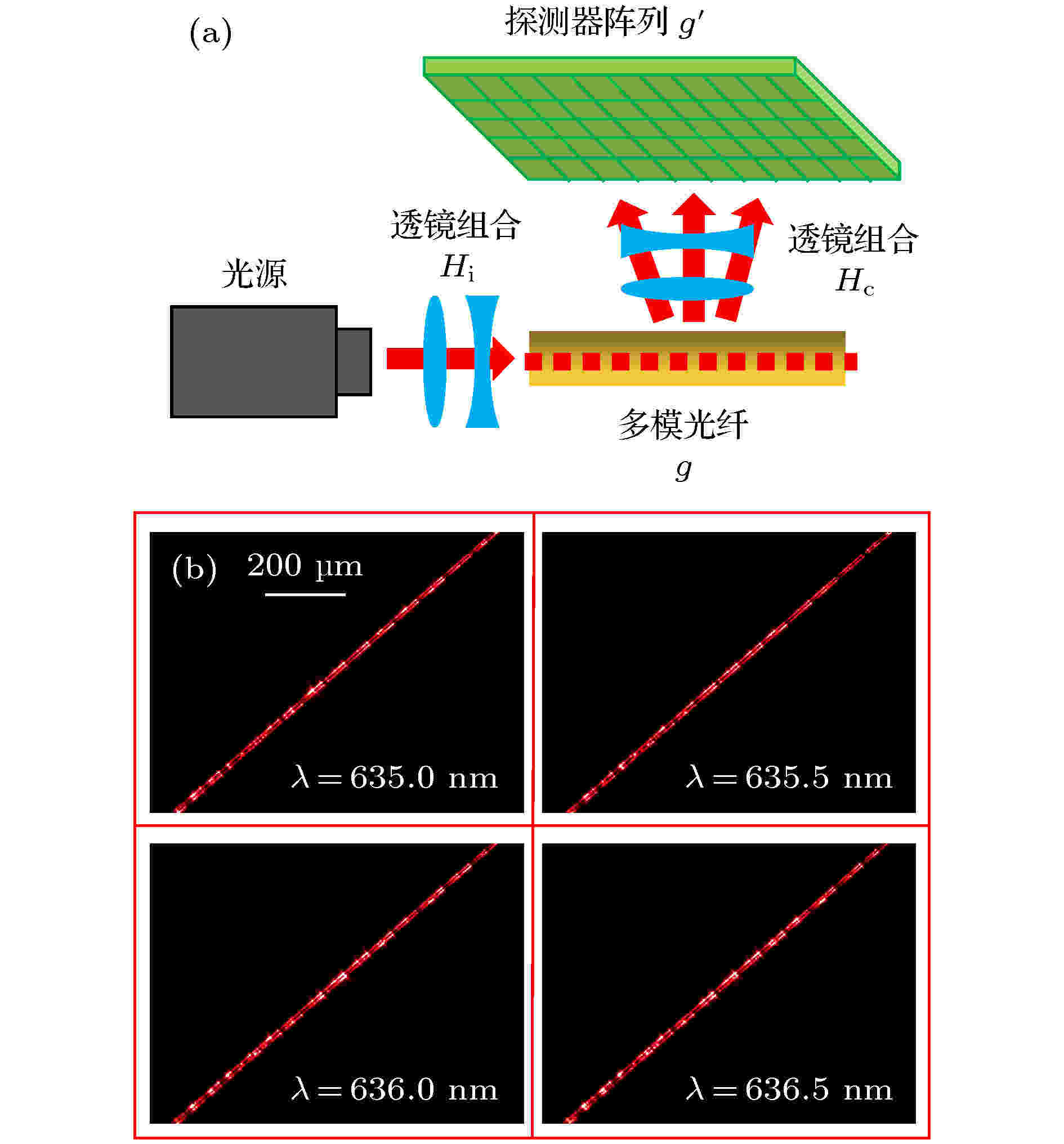
2020, 69 (13): 134204.
doi: 10.7498/aps.69.20200014
Abstract +
With the rapid development of integrated photonics, expensive and bulky commercial spectrometers force people to make more efforts to investigate high-performance, integrated and low-cost spectrometers. Spectrometers benefiting from the complementary metal-oxide semiconductor (CMOS) technology have greatly enriched the applications of spectrum detection while devices based on optical fibers still have potential development room. Owing to the strong dependence of multimode interference on wavelength generated in a multimode fiber, probe signals of arbitrary spectra could be detected by a detector array integrated on the top and reconstructed by using a compressive sensing (CS) algorithm. The CS algorithm has been widely used in signal processing, which saves more computing storage and time but maintains the same precision. With the interference pattern system, our spectrometer based on a fiber taper achieves a spectral resolution of 20 pm (one order of magnitude better than commercial spectrometers) and a detection bandwidth of more than 200 nm on a device length of 1 mm. After optimizing the energy function, the spectral reconstruction results show excellent detection capability and metamerism effect superior to RGB cameras or human eyes, providing a significant role for portable multi-functional on-chip systems in future.
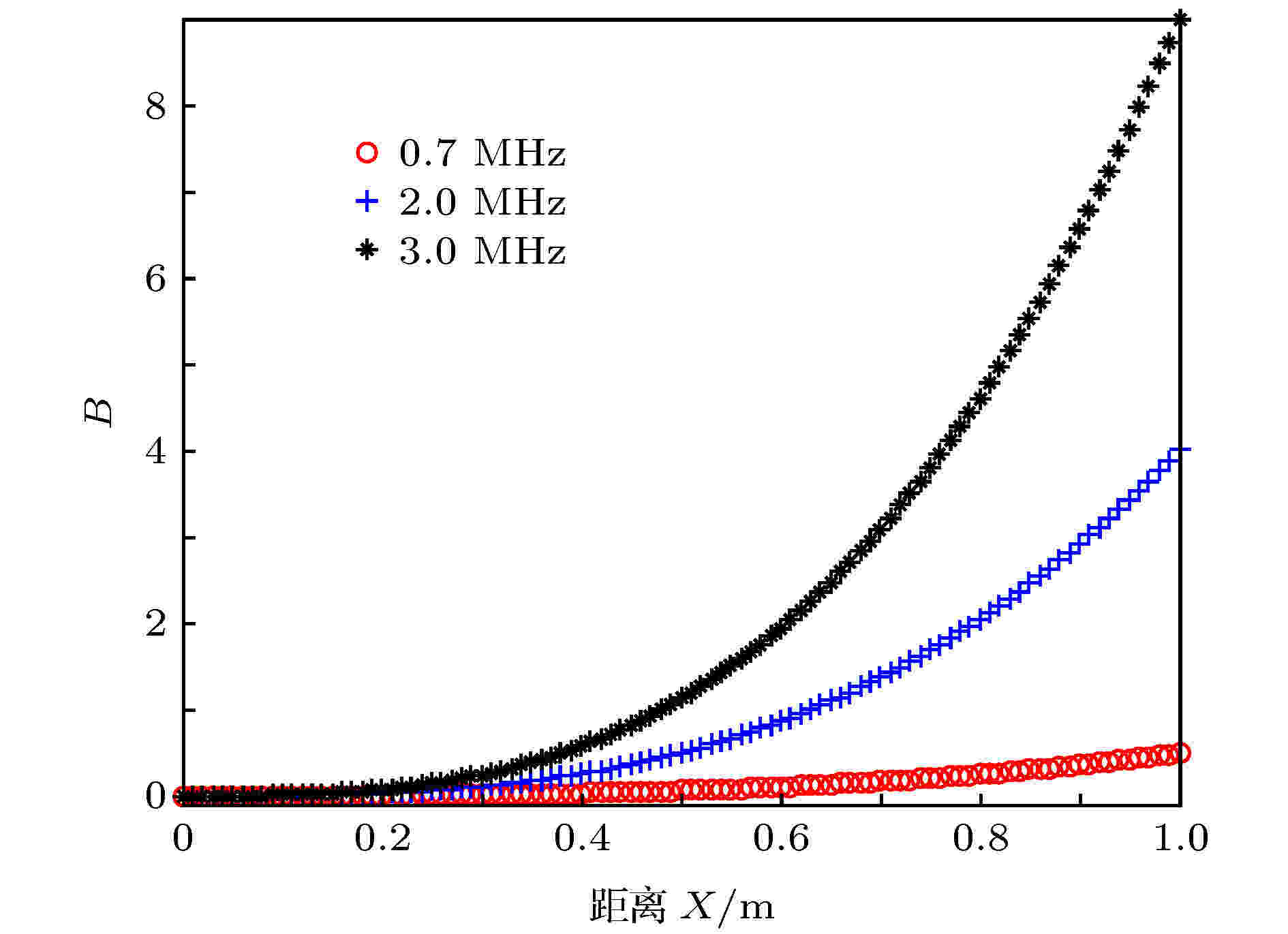
2020, 69 (13): 134301.
doi: 10.7498/aps.69.20200425
Abstract +
Recent work has rendered possible the formulation for the nonlinear propagation of pressure waves in liquids by using the generalized Navier - Stokes equations and the modified equations of state, with the heat transfer and fluid viscidity taken into consideration. And the nonlinear approximation solution of the second order term is obtained. The conclusion concerns the acoustic pressure, phase speed, attenuation, and velocity distribution function. When the amplitude of driving acoustic pressure is higher than the cavitation threshold of the host liquid, the cavitation occurs. The cavitation bubbles will prevent the sound field from spreading in the liquid, and the acoustic energy accumulates near the cavitation zone. So when studying the transmission characteristics of acoustic wave in the liquid, the cavitation attenuation must be considered. Note that the particularity of cavitation bubble movement, cavitation bubble vibration and viscous force are simulated under the initial driving sound. Through the analysis, it is found that the transmission of sound is influenced by the viscosity of the fluid, heat transfer, driving sound pressure (amplitude, frequency, duration) and cavitation bubble in liquid. The physical mechanism is that the higher driving pressure causes the cavitation to turn stronger, the acoustic loss to be faster, the sound propagation distance to be smalletr and the vibration of bubbles to transfer energy from the fundamental wave to harmonics. As a result, the stronger absorption from the liquid causes abnormal phenomena, and the output sound is lower finally. It shows that the nonlinear radial motion of cavitation bubble is mainly responsible for the sound intensity attenuation.
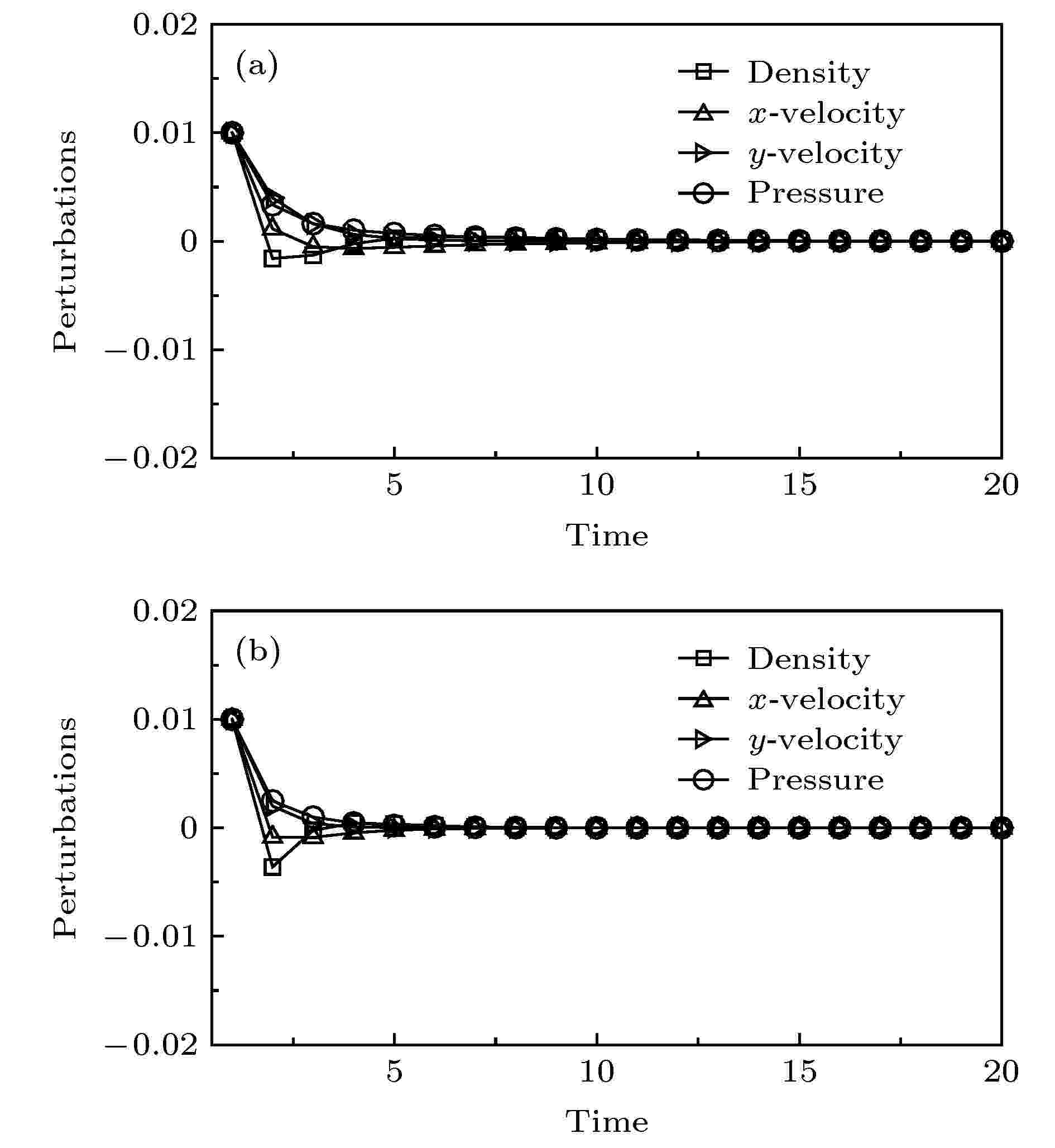
2020, 69 (13): 134701.
doi: 10.7498/aps.69.20191851
Abstract +
Reliable numerical simulations for hypersonic flows require an accurate, robust and efficient numerical scheme. The low-dissipation shock-capturing methods often suffer various forms of shock wave instabilities when used to simulate hypersonic flow problems numerically. For the two-dimensional(2D) inviscid compressible Euler equations, the stability analysis of the low-dissipation HLLEM scheme is conducted. The odd and even perturbations are added to the initial state in the streamwise direction and the transverse direction respectively, and the evolution equations of perturbations are deduced to explore the mechanism of instability inherent in the HLLEM scheme. The results of stability analysis show that the perturbations of density and shear velocity in the flux transverse to the shock wave front are undamped. Due to the symmetry, the 2D Sedov blast wave problem is computed to prove the multidimensionality of the shock instability. In the one-dimensional case which is free from the instability, the undamped property of density perturbation is also existent but no shear velocity is found. The conclusion can be drawn as follows: the shock instability of HLLEM scheme is triggered by the perturbation growth of shear velocity in the flux transverse to the shock wave front. Based on the conclusion of stability analysis, the instability of HLLEM scheme is cured by adding the shear viscosity to the transverse flux. In order to avoid affecting the resolution of the shear layer due to the introduction of too high shear viscosity, two functions to detect the shock wave and the subsonic regimes are defined, so that the shear viscosity is only added to the transverse flux in the subsonic regime of the shock layer, while the rest of numerical fluxes are still computed by the original HLLEM scheme. The results of stability analysis and some challenging numerical test problems show that the modified HLLEM scheme not only retains the merits of the original HLLEM, such as, resolving contact discontinuity and shear wave accurately, but also has greatly improved its robustness, inhibiting the unstable phenomena from occurring effectively when computing the strong shock wave problems.
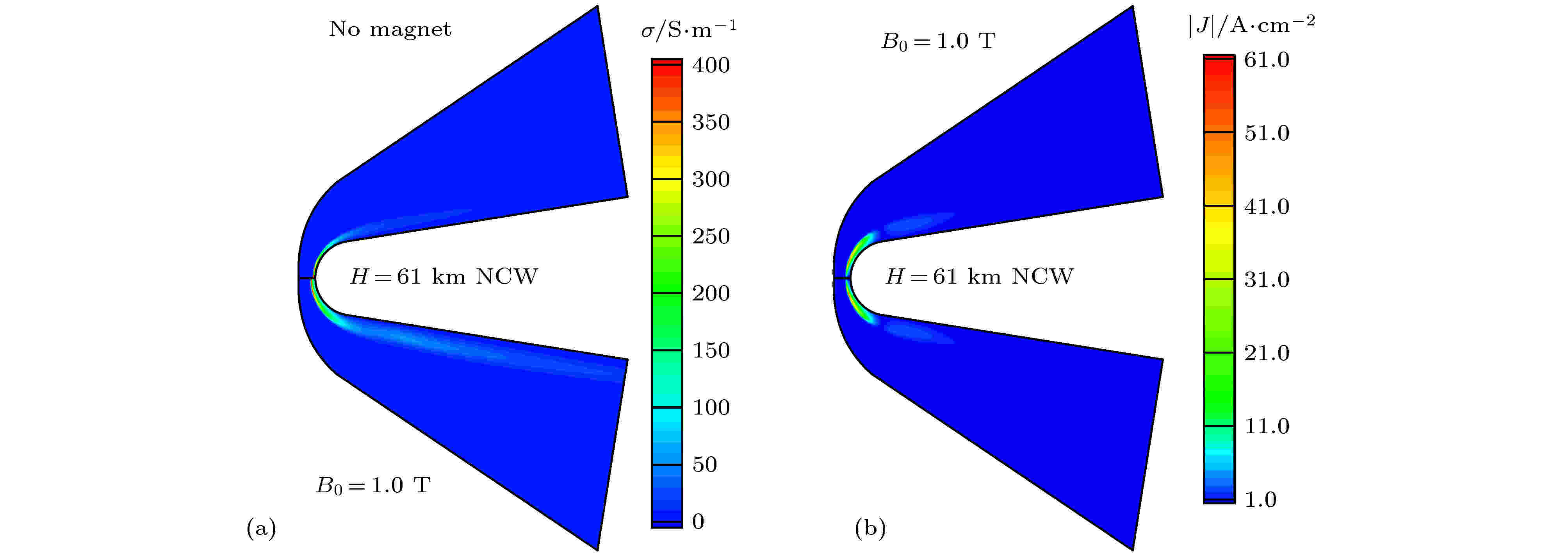
2020, 69 (13): 134702.
doi: 10.7498/aps.69.20200091
Abstract +
Aming at the applicability of low magnetic Reynolds number method, in this paper we analyze the differences in the application of low magnetic Reynolds number condition and the limitation of full MHD method when it is applied to hypersonic flow. According to the low magnetic Reynolds number magneto-hydrodynamic control numerical simulation method, computing magnetic vector potential through integrating induced current, and considering the reduction of computation domain caused by truncation factors, we propose a low magnetic Reynolds number MHD computation method which is adjusted by the induced magnetic field, and the validation of this method is also presented. Through the numerical simulation of RAM-C blunt cone in flight test condition, we analyze the discrepancy caused by “neglecting induced magnetic field”, and also discuss the principle of the application of low magnetic Reynolds number assumption of hypersonic flow. The obtained results are as follows. (1) The adjusted computation method developed in this paper breaks through the limit of low magnetic Reynolds number, and expands the application range of low magnetic Reynolds number method to hypersonic flow, the numerical simulation result is reliable; Compared with direct integration of Biot-Savart law, the computation efficiency is considerably improved. (2) In the hypersonic flow, the influence of induced magnetic field is presented, thus weakening and distorting the applied magnetic field macroscopically, as a result weakening the effect of magnetic control to some extent. Under the condition of this paper, the low magnetic Reynolds number condition “Rem < 0.1” is probably too conservative, and it is better to adopt Rem < 1.0, and the characteristic conductivity and characteristic length should be chosen according to the actual plasma distribution.
CONDENSED MATTER: STRUCTURAL, MECHANICAL, AND THERMAL PROPERTIES
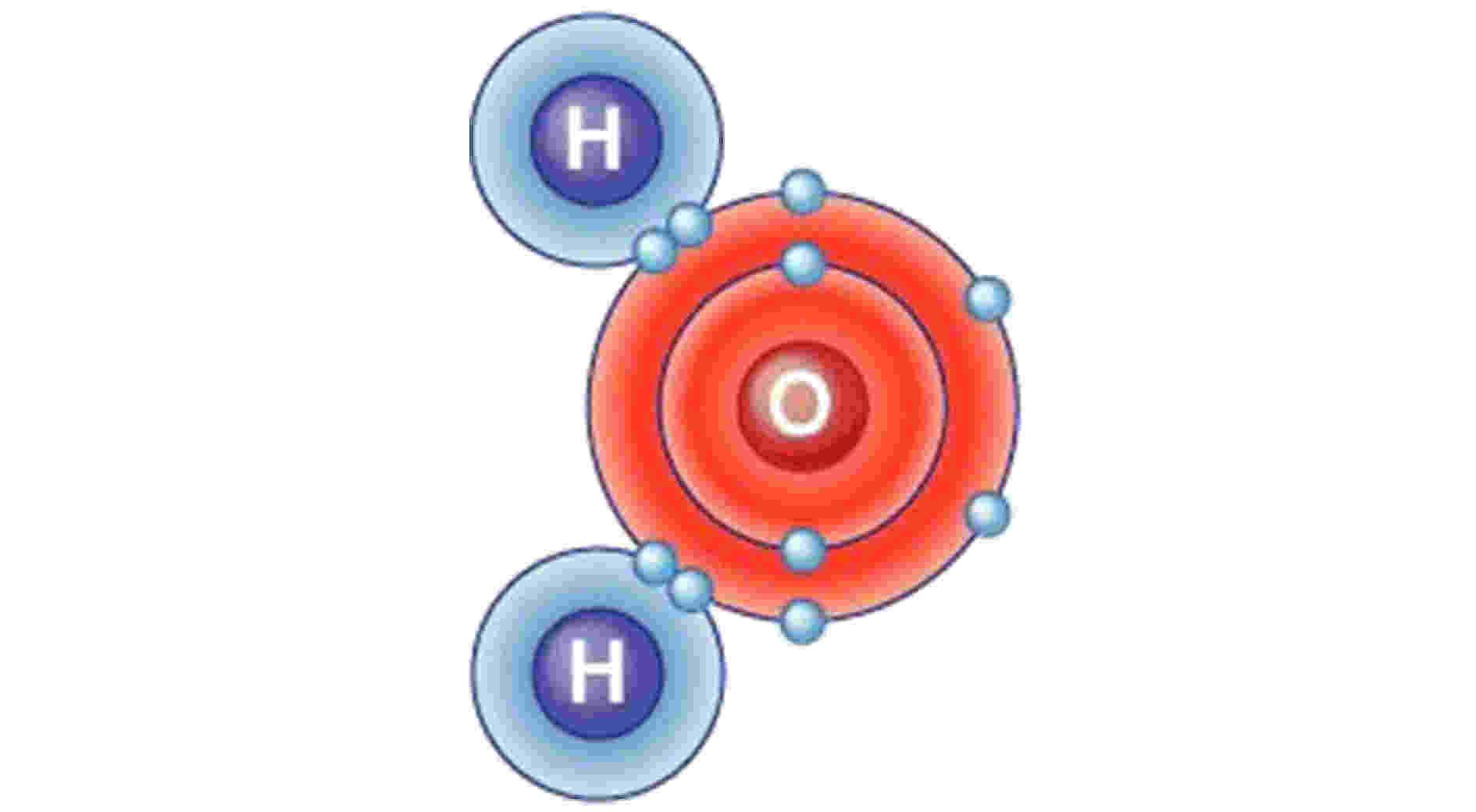
2020, 69 (13): 136101.
doi: 10.7498/aps.69.20191892
Abstract +
Silica glasses are composed of multi-oxides, apart from the major component silica. Though it is a general practice in the industries to prepare glasses at specific oxide ratios, the composition rule is largely missing, complicated by the implication of multi-oxides. Necessarily, their interpretation is rooted in chemical units, on which the specific compositions depend. However, in silica glasses the inter-atomic bonding network is continuous and there is no weak bonds, like the inter-molecular ones in molecular compounds, to define molecular entities that carry the chemical information of the materials. As the first stage towards understanding the composition rule, the present paper introduces a new method, so-called the cluster-plus-glue-atom model, to unveil the molecule-like structural units of the glass-relevant oxides. It is pointed out that their respective contributions to the construction of glass networks originate from their characteristic cluster structures, and from which molecule-like structural units are proposed that represent the smallest structural units of these oxides. Oxides participating in the glass network formation mainly present triangular or tetrahedral clusters which are required for a three-dimensional glassy network. For example, the basic network former SiO2 is formulated as [Si-O4]Si and contains 32 valence electrons. The intermediate oxides are characterized by the simultaneous formation of both octahedra and tetrahedra. The network modifiers present mainly cubes and octahedra. It is confirmed that the molecule-like structural units of the glass-formation oxides all meet octet rule (that is, the total number of valence electrons contained in each structural unit is an integer multiple of 8), just like common molecules. The proposed concept of molecular structural units sheds a new light on understanding the composition rule of silicate glasses and can eventually solve the long-standing problem of composition design of silica glasses.
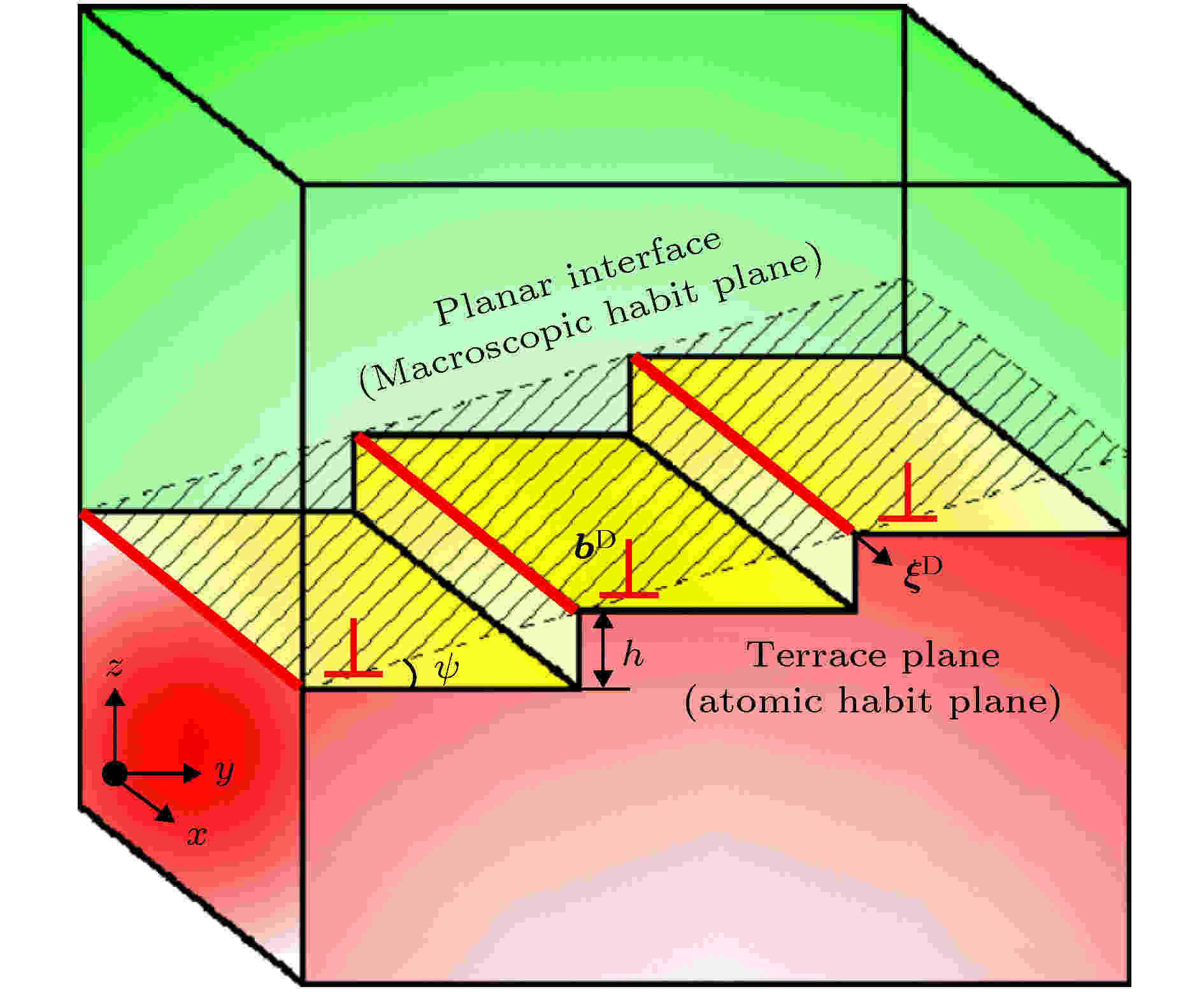
2020, 69 (13): 136102.
doi: 10.7498/aps.69.20191903
Abstract +
The martensitic transformation between the high-temperature face-centered cubic (FCC) phase and the low-temperature body-centered cubic (BCC) phase in iron-based alloys has been studied for years, which plays a critical role in controlling microstructures and hence properties of the alloys. Generally, the BCC structure martensitic phase forms from the FCC parent phase, involving a collective motions of atoms over a distance less than the interatomic distance in the vicinity of the interphase boundary. Thus the structure of interphase boundary separating the FCC and BCC phases is the key characteristics to quantitatively understanding the mechanism and kinetics of martensitic transformation. Due to the difficulty in observing the atomic motions taking place at a velocity as high as the speed of sound, the experimental investigation on the migration of FCC/BCC interphase boundary during the transformation is as yet limited. Noteworthily, molecular dynamics (MD) simulation has been applied to studying the martensitic transformation, in particular for investigating the mobility of the FCC/BCC interphase boundary in iron. However, in most of the MD studies the atomistically planar interfaces of {111}FCC // {110}BCC are considered as the initial configuration of the interphase boundary between FCC and BCC phases, which is in contradiction to the high-resolution TEM observations. In fact, the FCC/BCC interphase boundary, which is known as the macroscopic habit plane, is a semi-coherent interface consisting of several steps and terrace planes on an atomic scale. In the present work, the atomic configuration of a terrace-step FCC/BCC interphase boundary of iron is built in terms of the topological model. The MD simulation is conducted to clarify the mechanism of interphase boundary migration in the FCC-to-BCC transformation. The results show that the FCC/BCC boundary migrates along its normal at the expense of FCC phase as a result of the lateral motions of the transformation dislocations. Meanwhile, the interphase boundary maintains the stable terrace-step structure during the transformation. Further examinations reveal that the transformation dislocations move steadily at a velocity as high as (2.8 ± 0.2) × 103 m/s, affecting the migration of the interphase boundary with a constant velocity of about (4.4 ± 0.3) × 102 m/s. The effective migration velocity of FCC/BCC interface exhibits dynamic properties consistent with the characteristic features commonly observed in a displacive martensitic transformation. Additionally, the motion of transformation dislocations gives rise to the macroscopic shape strain composed of a shear component $ {\varGamma _{{\rm{yz}}}} = 0.349$ parallel to the boundary and a dilatation $ {\varGamma _{{\rm{zz}}}} = 0.053$ normal to the boundary in the MD simulation, which is close to the crystallographic calculations by the topological model.
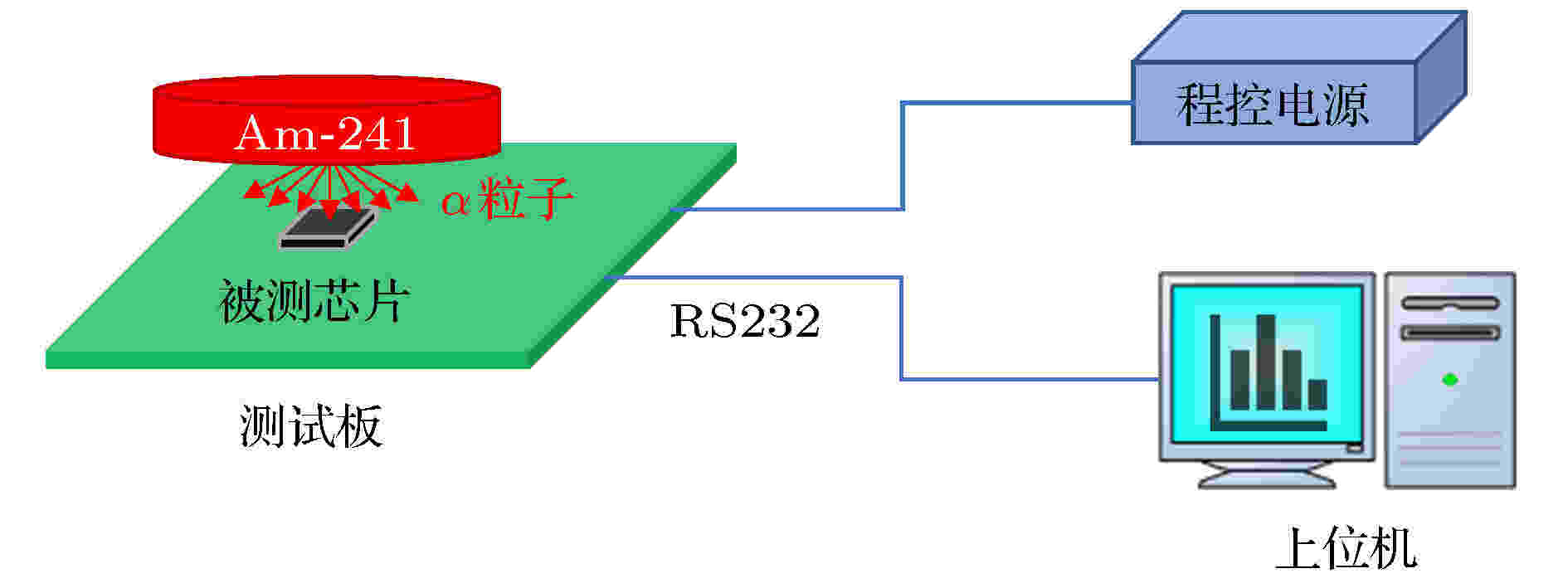
2020, 69 (13): 136103.
doi: 10.7498/aps.69.20201796
Abstract +
In this paper, the Am-241 is used as an alpha particle radioactive source to investigate the soft error mechanism in 65-nm and 90-nm static random accessmemory (SRAM). Combining reverse analysis, TRIM and CREME-MC Monte Carlo simulation, the energy transport process, deposited energy spectrum and cross-section characteristics of alpha particles in the device are revealed. The results show that the soft error sensitivity of the 65-nm device is much higher than that of the 90-nm device, and no flipping polarity is found. According to the real-time measured soft error rate at an altitude of 4300 m in Tibetan Yangbajing area, the thermal neutron sensitivity and alpha particle soft error rate, the overall soft error rate of 65-nm SRAM used at sea level of Beijing city is 429 FIT/Mb, and the contribution from alpha particles is 70.63%. Based on the results of reverse analysis, a three-dimensional simulation model of the device is constructed to study the influence of the incident angle of alpha particles on the single event upset characteristics. It is found that the corresponding deposition energy value at the peak of the number of particles in the sensitive region decreases by 40% with the incident angle increasing from 0° to 60°. While the single event upset cross sectionincreases by 79% due to the apparent single event upset edge effect in a sensitive region of the 65-nm device.
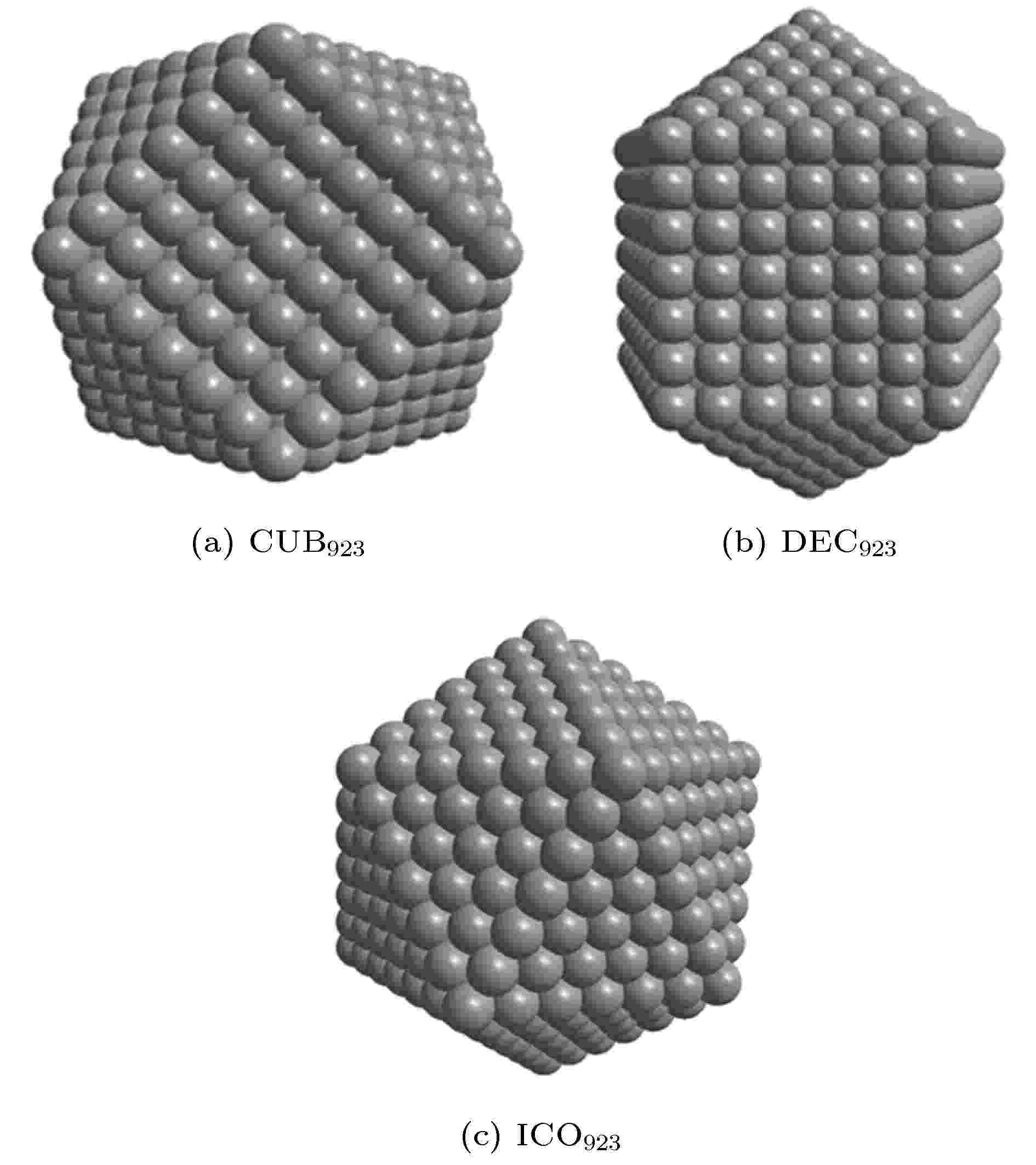
2020, 69 (13): 136601.
doi: 10.7498/aps.69.20200120
Abstract +
NiAl nanoparticles possess high-energy density and good mechanical properties at elevated temperatures, and are considered as an important material. However, the differences in the diffusion behavior of Al adsorbed atoms on different Ni substrate surfaces and the effects of different diffusion mechanisms on the deposition growth of Al atoms on the Ni substrate surface are highly desired to be clarified. Therefore, in the present work, the diffusion behavior of single Al adsorbed atoms and nanoparticle cluster growth on the Ni substrate surface of decahedral (DEC), cuboctahedral(CUB) and icosahedral(ICO) structures are systematically studied by molecular dynamics (MD) throuh analyzing the embedded atom potentialand using the nudged elastic band method. The diffusion barriers of Al adsorbed atoms on three different Ni substrates are calculated by nudged elastic band methodand analyzed, showing that the diffusion barrier is greatly affected by the smoothness of the step edge and the atomic coordination number of substrate as well. The diffusions of Al adsorption atoms on the surfaces of three Ni substrates are realized by two mechanisms, namely exchanging or hoping, and the lowest Ehrlich-Schwoebel (ES) barrier is 0.38 eV for exchange CUB{111} → {100}, 0.52 eV for exchange DEC{111} → {100}, and 0.52 eV for hoping ICO {111} → {111}. The exchanging mechanismsupports Al adatoms diffusing from {111} to {100} facet on the three Ni substrates, while the diffusion between two adjacent {111} facets is mainly driven by the hoping mechanism. On this basis, atom-by-atom growth MD simulation is used to study the structure of the Ni-Al cluster. The deposited Al atoms first tend to diffuse near the edges of the steps and the vertices. The deposited Al atoms begin to aggregate into islands with the increase of their number. For Al atoms on the Ni cluster, a good Ni-core/Al-shell structure can be obtained by depositing Al atoms on the surface of Ni substrate at lower temperatures. In this core-shell structure, Al atoms have a larger surface energy and atom radius compared with Ni atoms. For the ICO substrate, the corresponding defect number of core-shell clusters is smaller than for the CUB and the DEC substrate, which is in good agreement with the diffusion behavior of Al adsorbed atoms on the Ni substrate cluster surface. The surface of Ni-Al bimetal is gradually alloyed with the increase of growth temperature. This study provides a good insight into the diffusion and growth of Al adsorbed atoms on Ni substrates surface on an atomic scale.

EDITOR'S SUGGESTION
2020, 69 (13): 136701.
doi: 10.7498/aps.69.20200603
Abstract +
In this paper, we study the spatial noise fluctuations of the density distribution of non-interacting 6Li ultracold Fermi gases. For ideal ultracold Fermi gases, the Fermi-Dirac statistics governs its quantum distribution. The suppression of density fluctuations at low temperature, due to Pauli exclusion principle, is observed in a large cloud of fermions. To clearly reveal the density noise fluctuations of the ideal Fermi gases, other noises, such as the background noise, imaging laser noise, CCD photon counting noise, are greatly suppressed. The noise fluctuation shows a sub-Poissonian statistics in excess of 10,000 atoms per spin state. The dependence of the spatial atom noise fluctuation on the quantum degeneracy is also investigated by changing the temperature of the degenerated Fermi gases. The Fermi gases with lower temperature exhibit larger suppression of the noise fluctuations. The results may have great applications in measuring the temperature of strongly correlated many-body physics and observing the phase transition of incompressible quantum phases.
CONDENSED MATTER: ELECTRONIC STRUCTURE, ELECTRICAL, MAGNETIC, AND OPTICAL PROPERTIES

2020, 69 (13): 137801.
doi: 10.7498/aps.69.20191960
Abstract +
Two dimensional materials have been attracting intensive interest due to their unique physical and optoelectronic properties. As an emerging two dimensional materials, SnSe2 have shown a considerable potential for next-generation electronic and optoelectronic. Herein, SnSe2 bulk crystals have been prepared by a chemical vapour transport method with high purity tin and selenium powder as precursors. Then SnSe2 multilayers has been successfully prepared by a micromechanical exfoliation method from the SnSe2 bulk crystals. The phase structures and elemental composition of the bulk crystal are investigated using an X-Ray diffractometer, an X-ray photoelectrons spectrometer and a Raman spectrometer. And the morphologies are observed using an optical microscope, an atomic force microscope and a transmission electron microscope. The measurement results show that the SnSe2 bulks are single crystals with a high crystallization and purity. The SnSe2 multilayers have a size of 25–35 μm and a thickness of 1.4 nm. To detect the electronic and photoresponse characteristics of the SnSe2 multilayers, a field effect transistor based on such SnSe2 are fabricated via a photolithographic-pattern-transfer method. The transistor has a smooth surface without wrinkles and bubbles, and also has a good contact with Au electrodes. The transistor shows a linear output characteristic and an obvious rectification. The on/off ratio of the device is 47.9 and the electron mobility is 0.25 cm2·V–1·s–1. As a photodetector, the field effect transistor exhibits obvious photoresponse to three visible lights with the wavelengths of 405, 532, and 650 nm. As the lasers are turned on and the device is under illuminations of three visible lights, the current increase rapidly to a saturation state. Then as the lasers are switched off, the current decrease and recover to the original state. The drain-source current can alternate between high and low states rapidly and reversibly, which demonstrates photoresponse characteristics of the devices are stable and sensible. Notably, it shows a strongest response to the 405 nm light at an intensity of 5.4 mW/cm2 with a high responsivity of 19.83 A/W, a good external quantum efficiency of 6.07 × 103%, a normalized detectivity of 4.23 × 1010 Jones, and a fast response time of 23.8 ms. The results of this work demonstrate that layered SnSe2 can be a suitable and excellent candidate for visible light photodetector and has a huge potential for high-performance optoelectronic devices.

EDITOR'S SUGGESTION
2020, 69 (13): 137802.
doi: 10.7498/aps.69.20200353
Abstract +
Based on the structural characteristics of the few-mode multicore fiber (FM-MCF), a multi-channel FM-MCF surface plasmon resonance (SPR) biosensor with open air-hole is presented. Due to the air-hole distribution of the FM-MCF, the six outer air-holes naturally become open air-holes, i.e. groove sensing channels, fabricated by chemical etching. Then, compared with D-shape structure, tapered structure of fiber and air-hole of photonic crystal fiber (PCF), the open groove structure is easy to accommodate the liquid analyte. In order to obtain better sensing performance, a sensing model of the presented FM-MCF SPR biosensor with sensitive dielectric layer is established and numerical simulations are performed using the finite element method. In the simulations, the effect of core-hole distance, coating thickness, sensing dielectrics, transmission modes in optical fiber on the sensing performance as well as the role of multi-channel are analyzed. The simulation results show that when the air-hole is tangent to the core (d = 0 μm), the FM-MCF SPR biosensor has the better performance because the core-hole distance d determines the leakage intensity of the evanescent wave. As the evanescent field excited by high-order mode (LP11ax mode) is stronger than that by fundamental mode (LP01x mode), the performance of biosensors for SPR excitation by using high-order mode is better than by using fundamental mode. Meanwhile when the coating thickness of gold, silver and indium tin oxides (ITOs) is 40 nm, 30 nm and 100 nm respectively, the FWHM of loss spectrum reaches a minimum value, which means that the presented biosensor has the better performance in this sense. For the case of different sensing dielectrics, it is observed that the resonance wavelength of gold and silver film are in the visible wavelength range, while the ITO is at near-infrared wavelength. Then it is useful for our biosensor to simultaneously detect many liquid analytes in one SPR transmittance spectrum. In addition, the calculation results also show that when one of the groove channels is coated with 100 nm ITO for the LP11ax mode, the FM-MCF SPR biosensor has a highest sensitivity of 20824.66 nm/RIU and refractive index (RI) resolution is 4.8 × 10–6 RIU with the surrounding RI changing from 1.33 to 1.39, in which the RI of bovine serum albumin (BSA) solution, human Immunoglobulin G and C-reactive protein can be detected. Moreover, when the outer groove channels of our biosensor are coated with gold, silver and ITO film with different thickness, many biological liquid analytes can be detected separately or the same biological liquid analyte can be detected jointly, which reveals that the control flexibility of the groove sensing channel and the diversity of the detection analytes .
INTERDISCIPLINARY PHYSICS AND RELATED AREAS OF SCIENCE AND TECHNOLOGY
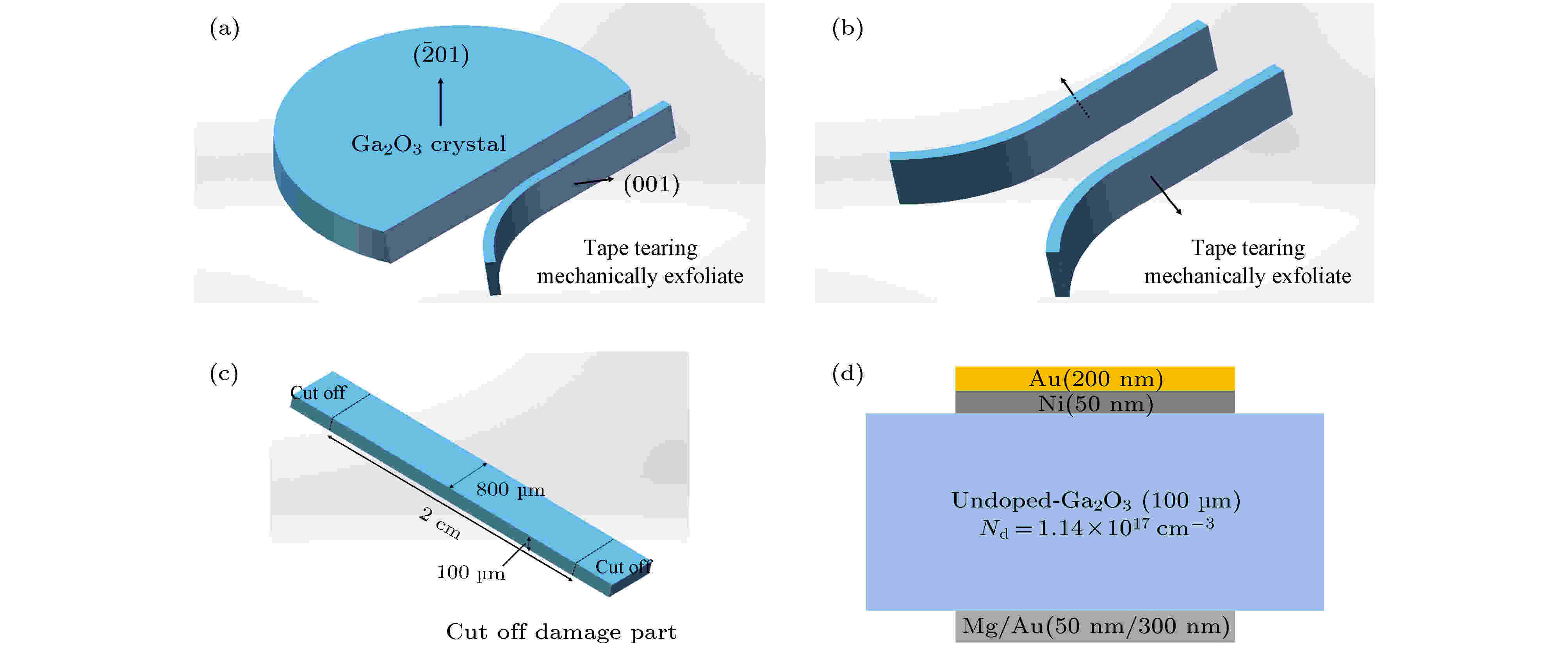
2020, 69 (13): 138501.
doi: 10.7498/aps.69.20200424
Abstract +
In this paper, a Ni/Au vertical structure Schottky diode based on mechanically exfoliated β-Ga2O3 is fabricated. The temperature dependent characteristics of I-V curves are measured. The device shows a good rectifying behavior. As the temperature increases from 300 K to 473 K, the barrier height increases from 1.08 eV to 1.35 eV, and the ideal factor decreases from 1.32 to 1.19. Both of them show strong temperature dependence, which indicates that the Schottky barrier of the device is inhomogeneous. The device has a double exponential forward I-V characteristic curve, which may be related to crystal defects, surface states, surface energy band bending and the effect of mechanical exfoliation from the crystal surface. Through Cheung's method and Norde's method, the series resistances and barrier heights of the device at different temperatures are extracted. It is found that the parameters extracted by the Norde's method are in good agreement with the values obtained from the forward I-V curve. The series resistance decreases with temperature increasing, which is mainly caused by the increase of the concentration of thermally excited carriers. In this paper, the temperature characteristics of the device are modified by the Gauss distribution of the barrier height. The corrected barrier height is 1.54 eV and Richardson's constant is 26.35 A·cm–2·K–2, which is closer to the theoretical value. It shows that the I-V temperature characteristics of Au/Ni/β-Ga2O3 Schottky diodes can be described by the thermionic emission model of the Gauss distribution barrier height accurately. There are a lot of surface states on the surface of Ga2O3 single crystal obtained by Mechanical exfoliation, which has a great influence on the Schottky contact of the device and may lead to the inhomogeneity of Schottky barriers. At the same time, due to mechanical exploiation, the surface of gallium oxide single crystal material is not completely continuous, and the single crystal surface has layered or island structure. This will also cause the inhomogeneous Schottky barrier height. Considering the influence of inhomogeneous barrier on Schottky diode, the method of measuring the temperature characteristics is more suitable to extracting the electrical parameters of β-Ga2O3 Schottky diodes than the method of fitting I-V forward curve by TE model.
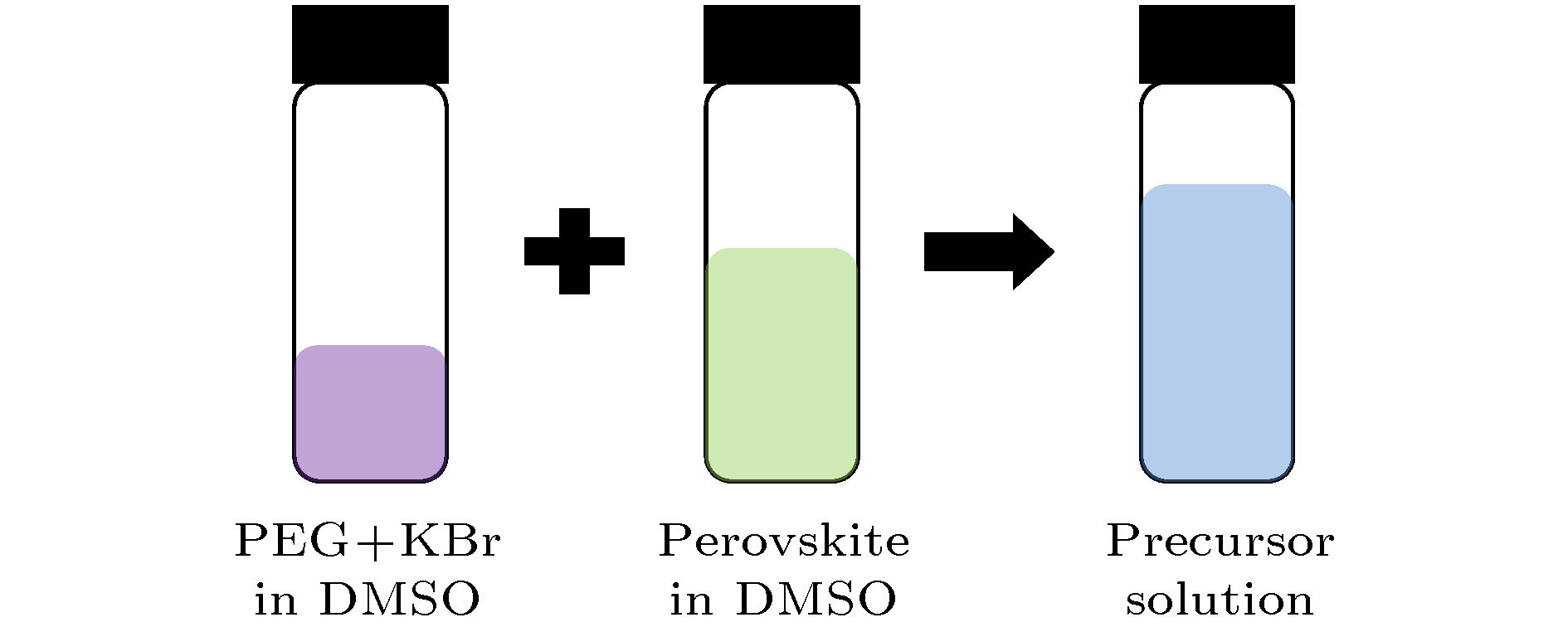
COVER ARTICLE
2020, 69 (13): 138502.
doi: 10.7498/aps.69.20200566
Abstract +
Solution-processable metal halide perovskites materials have many advantages, such as adjustable band gap, high photoluminescence quantum yield (PLQY), high color purity, high carrier mobility, low temperature solution process, excellent charge transport property and so on. These make them potential application in the display field. In the past few years, the device performance of perovskite light emitting devices (PeLEDs) have been greatly improved by manipulating the perovskite microstructures through various strategies, such as stoichiometry control, dimensional engineering, defect passivation and so on. At present, except for blue PeLEDs, the external quantum efficiencies (EQEs) over 20% have been achieved for green, red, and near-infrared PeLEDs. The low efficiency of blue PeLEDs is retarding their potential applications in full-color display and solid-state lighting. The main reasons in blue PeLEDs are the poor film coverage of blue perovskite materials and the spectral instability during device operation. In order to improve the quality of perovskite film and device performance, the quasi two-dimensional perovskite materials phenylethylammonium cesium lead bromide chloride (PEAxCsPbBr3–yCly) are used as the main perovskite emission material, by partially replacing Br with Cl to enlarge their bandgap to achieve the blue emission. The Lewis base polyethyleneglycol (PEG) is introduced to passivate the surface trapping defects and improve perovskite film coverage. The potassium bromide (KBr) is introduced to reduce perovskite grain size, suppress mobile ion migration and exhibit excellent spectral stability. Dual additives PEG and KBr are incorporated into the quasi-2D blue perovskite for inhibiting the nonradiative losses by passivating the traps in the perovskite films. Eventually, the PEAxCsPbBr3–yCly + PEG + KBr based blue PeLEDs with the emission peak of 488 nm are accompanied, which maximum brightness, current efficiency, and external quantum efficiency reached 1049 cd·m–2, of 5.68 cd·A–1, and of 4.6%, respectively, with high color purity (the Commission Internationale de L'Eclairage (CIE) chromaticity coordinates is (0.0747, 0.2570)) and the narrow full width at half maximum (FWHM) of 20 nm. Compare to the devices without additives, the efficiency has increased by nearly 3 times. Furthermore, the devices also show better spectral stability and operation lifetime. This work provides an effective method of blue PeLEDs toward the practical applications.
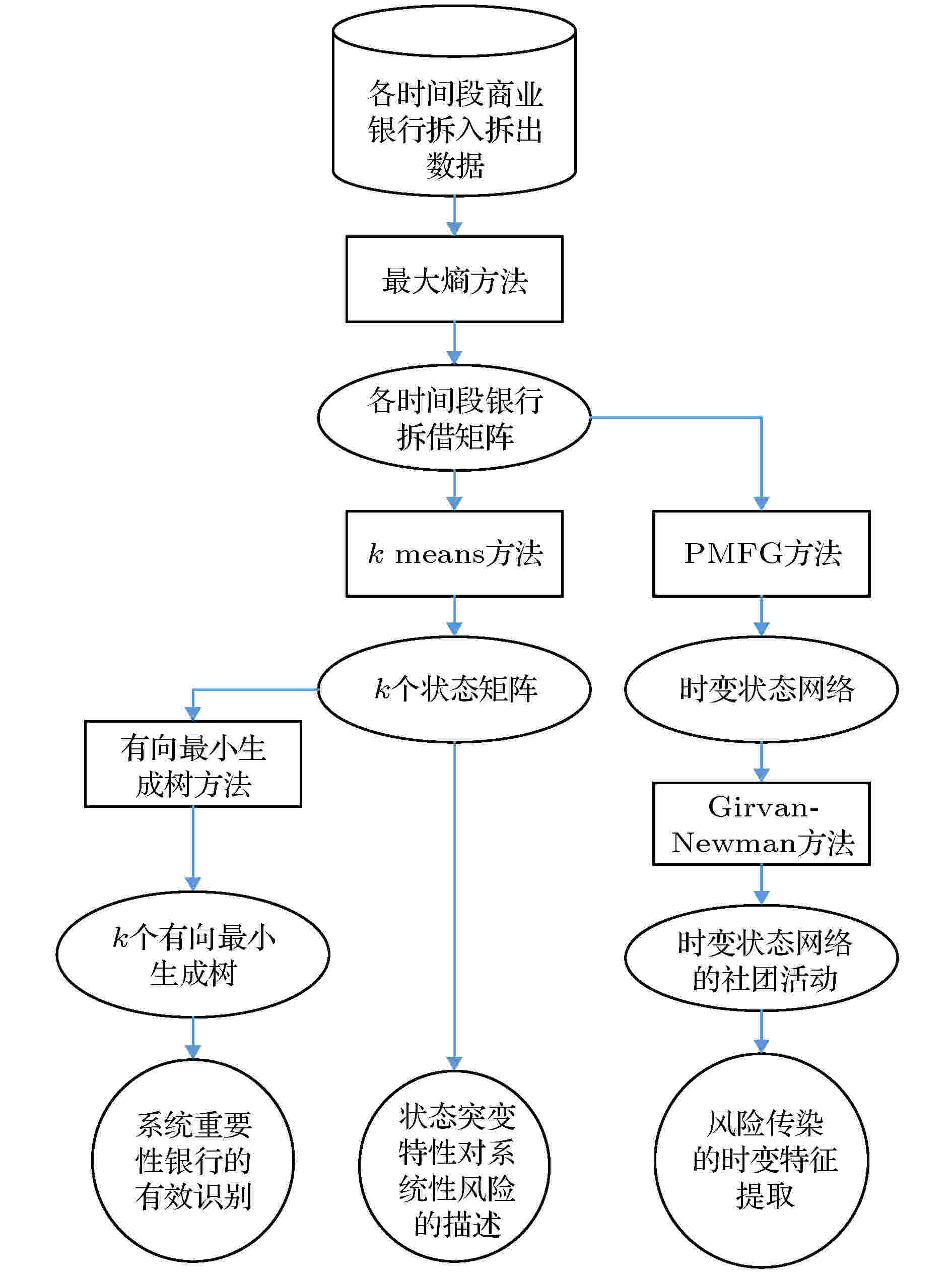
2020, 69 (13): 138901.
doi: 10.7498/aps.69.20200221
Abstract +
Aiming at the state transition between bank networks, we propose a time-varying state network model. In this model, we classify the bank networks in each time period by the kmeans method, and use directed minimum spanning tree(DMST) method to describe the topological structure of each kind of bank network. We also construct a time-varying bank state network by the planar maximally filtered graph(PMFG) method. The state network can be used to find the source of bank risk and conduct the time-varying analysis. We put into the model the inter-bank lending data of 15 listed Chinese commercial banks from the fourth quarter of 2007 to the first quarter of 2019. The results show that the short-term continuity jump between the bank states can effectively describe the occurrence of financial crisis. For example, before and after the global financial crisis in 2008, there was a short-term jump between two states. From the “money shortage” in 2013 to the stock market crash in 2015, there were four short-term jumps between states. At the same time, the outgoing degree of each directed bank state network is directly proportional to the contagion effect, and the incoming degree is inversely proportional to the steady degree of the risk faced by the bank. The sequential bank state network has the memory characteristic, which can provide the central bank for decision basis to prevent the systematic risk.








